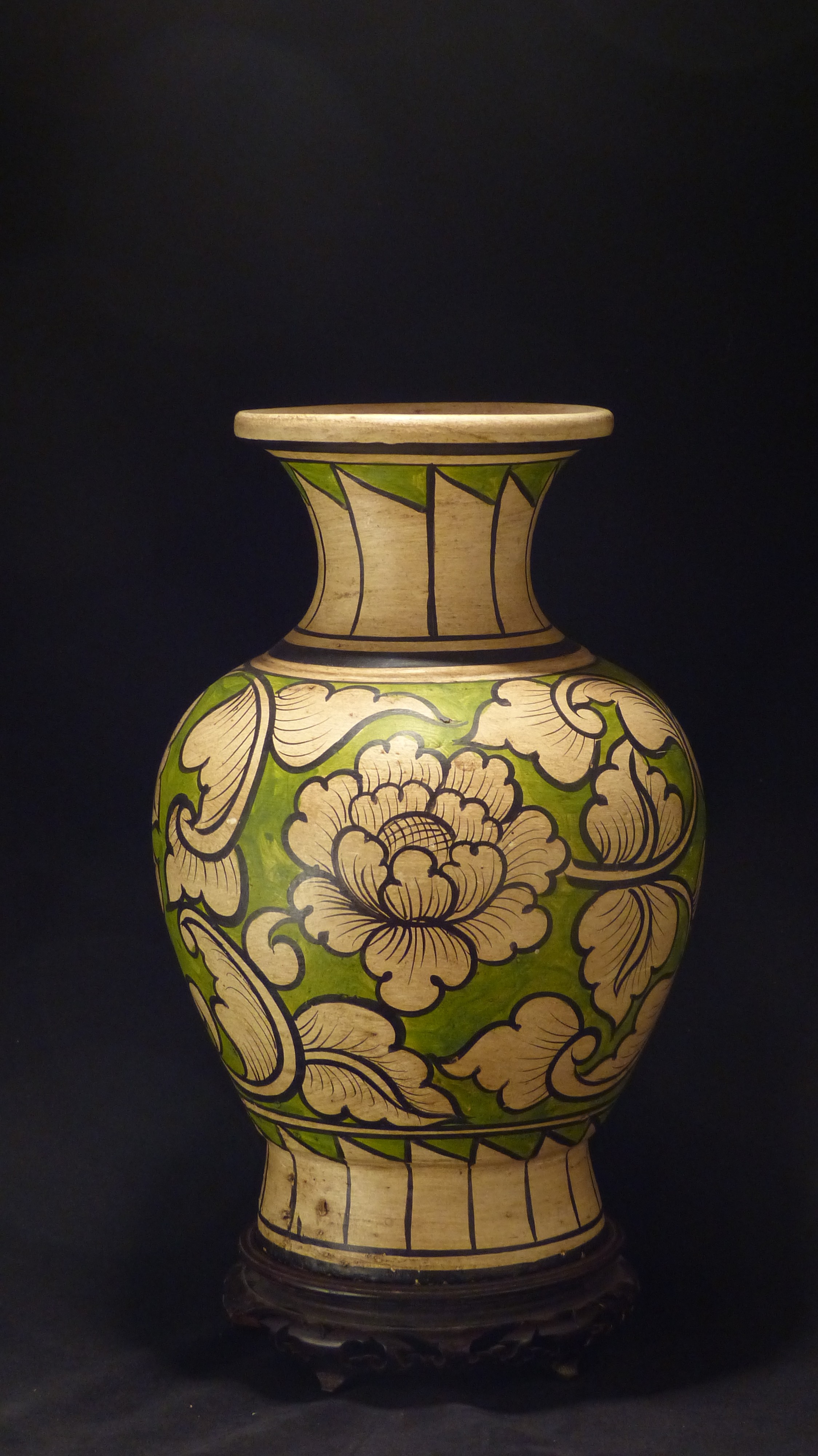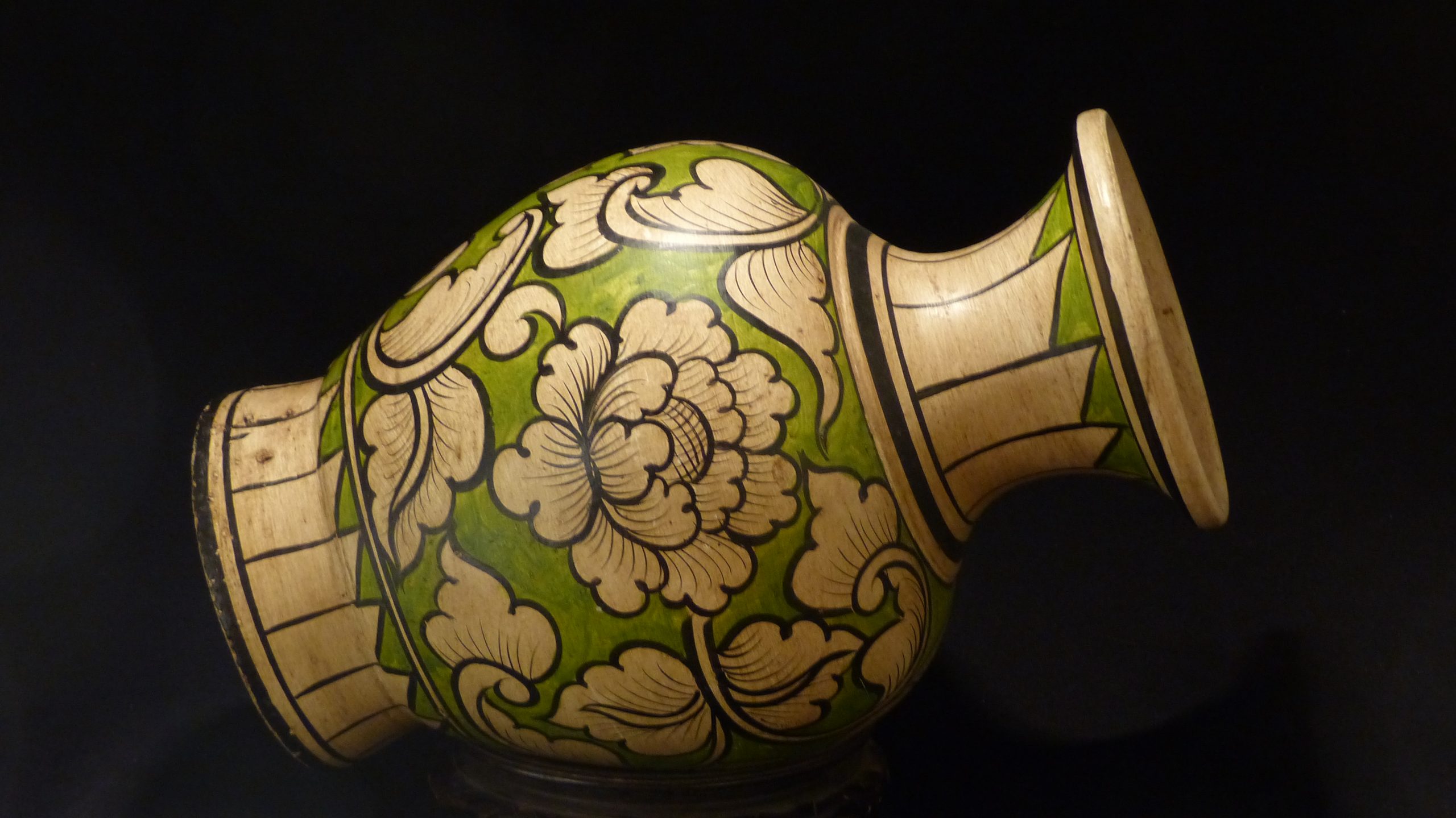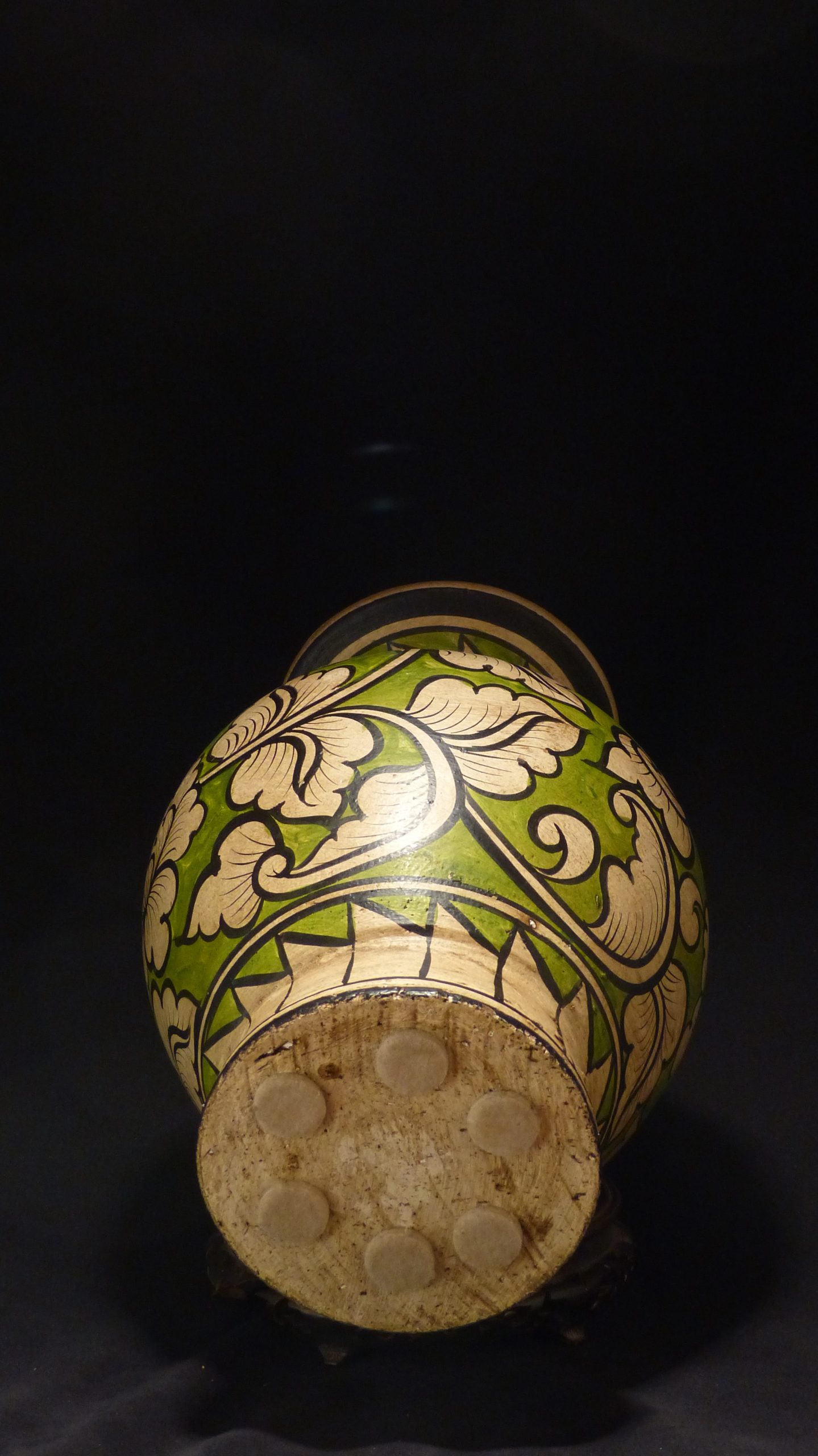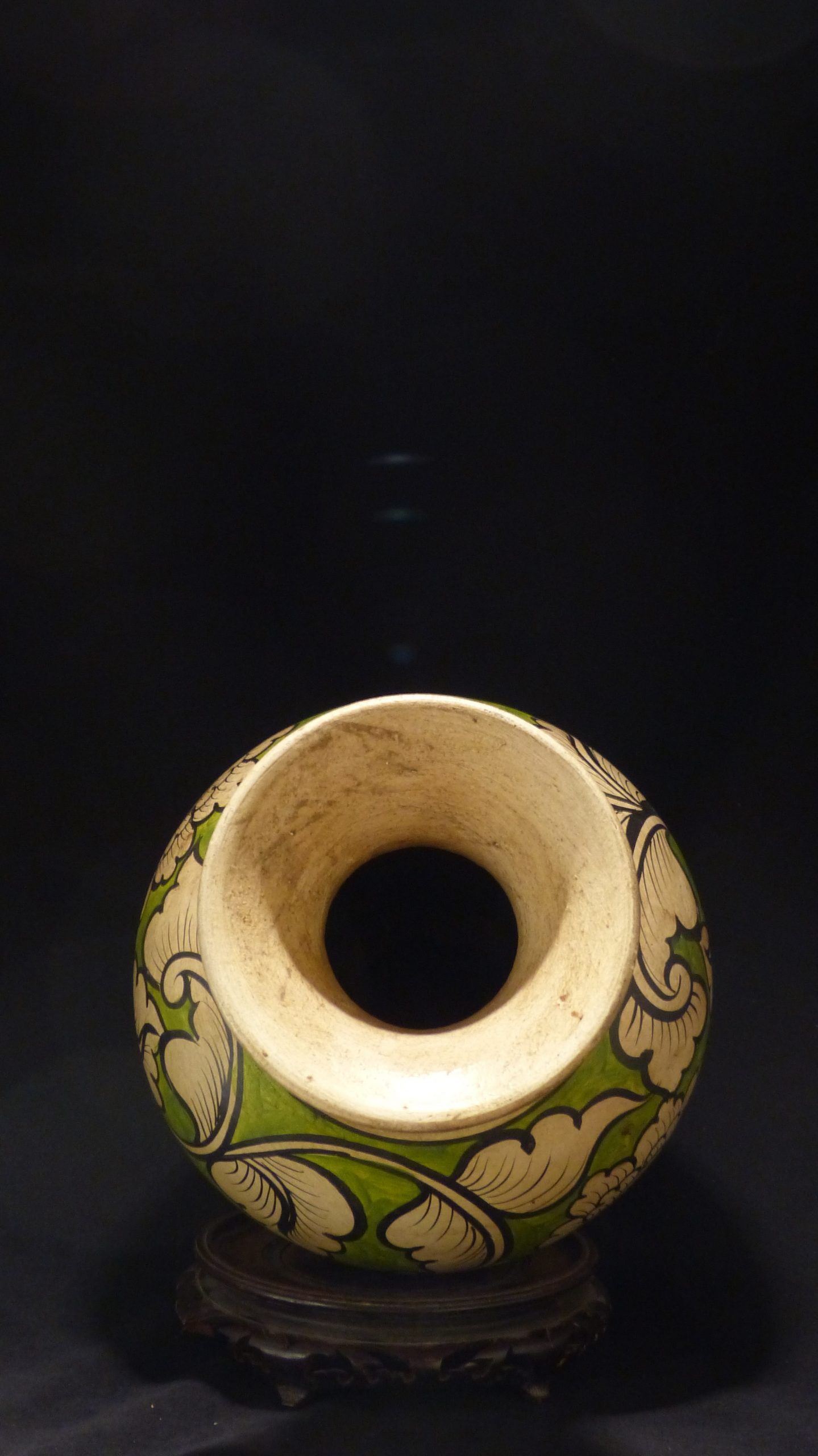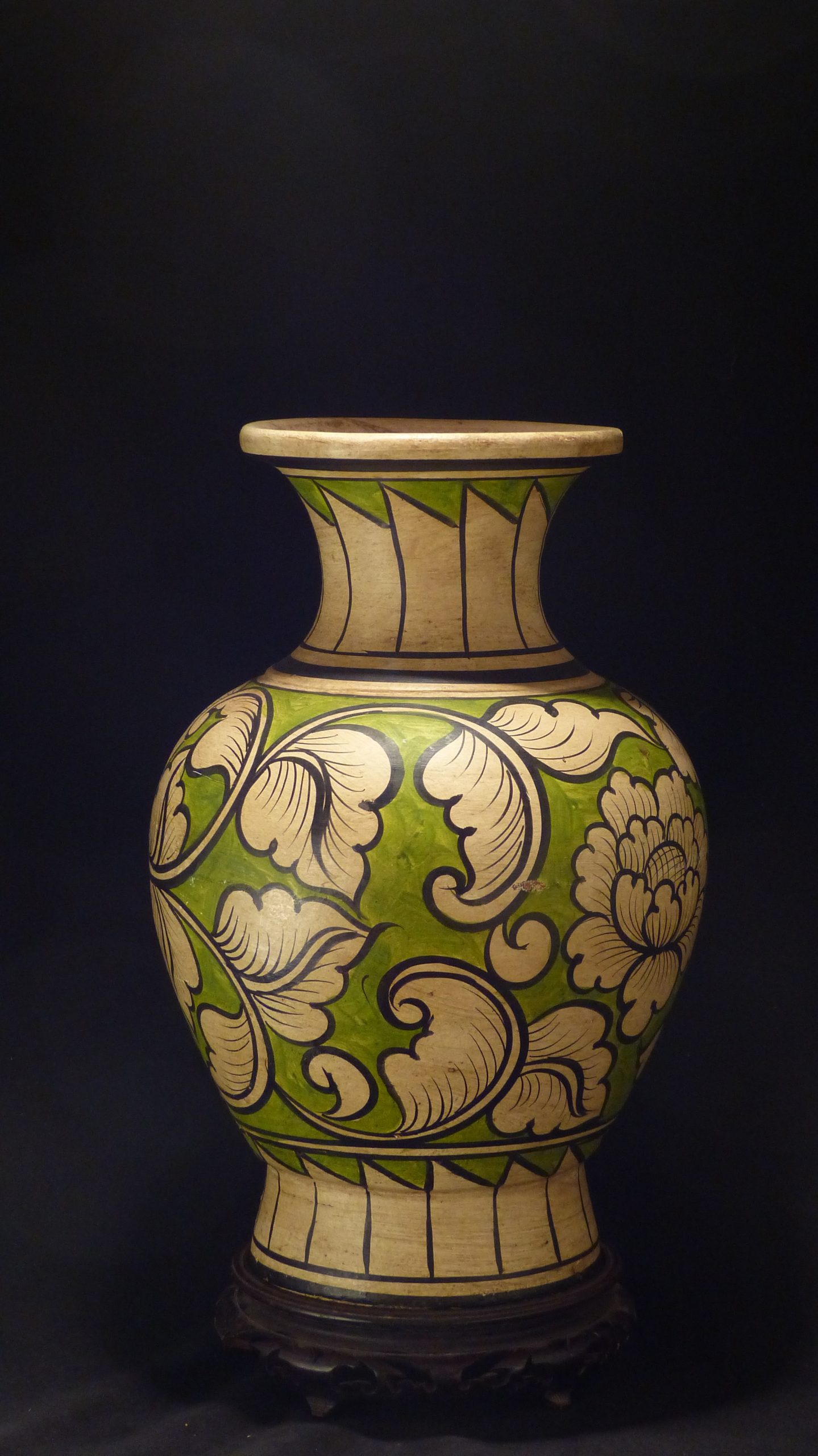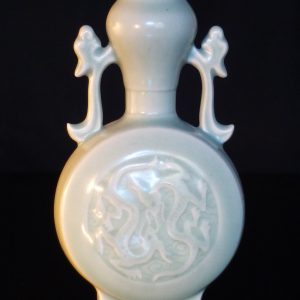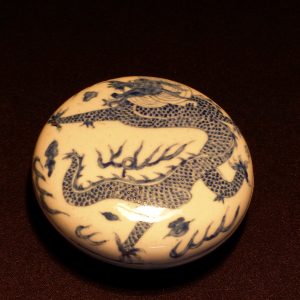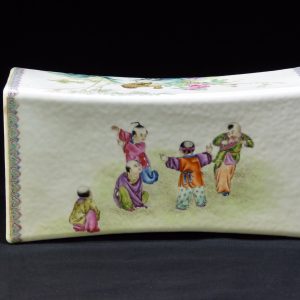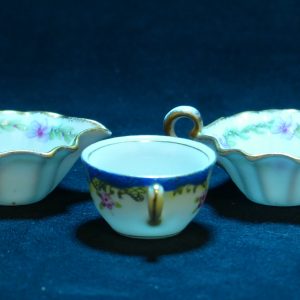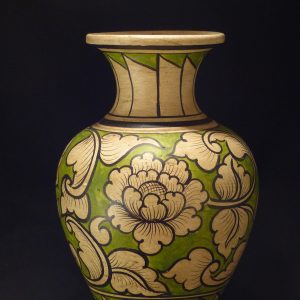Description
南宋 吉州窑 磁州窑牡丹纹瓶金
磁州窯白地鐵繪牡丹纹
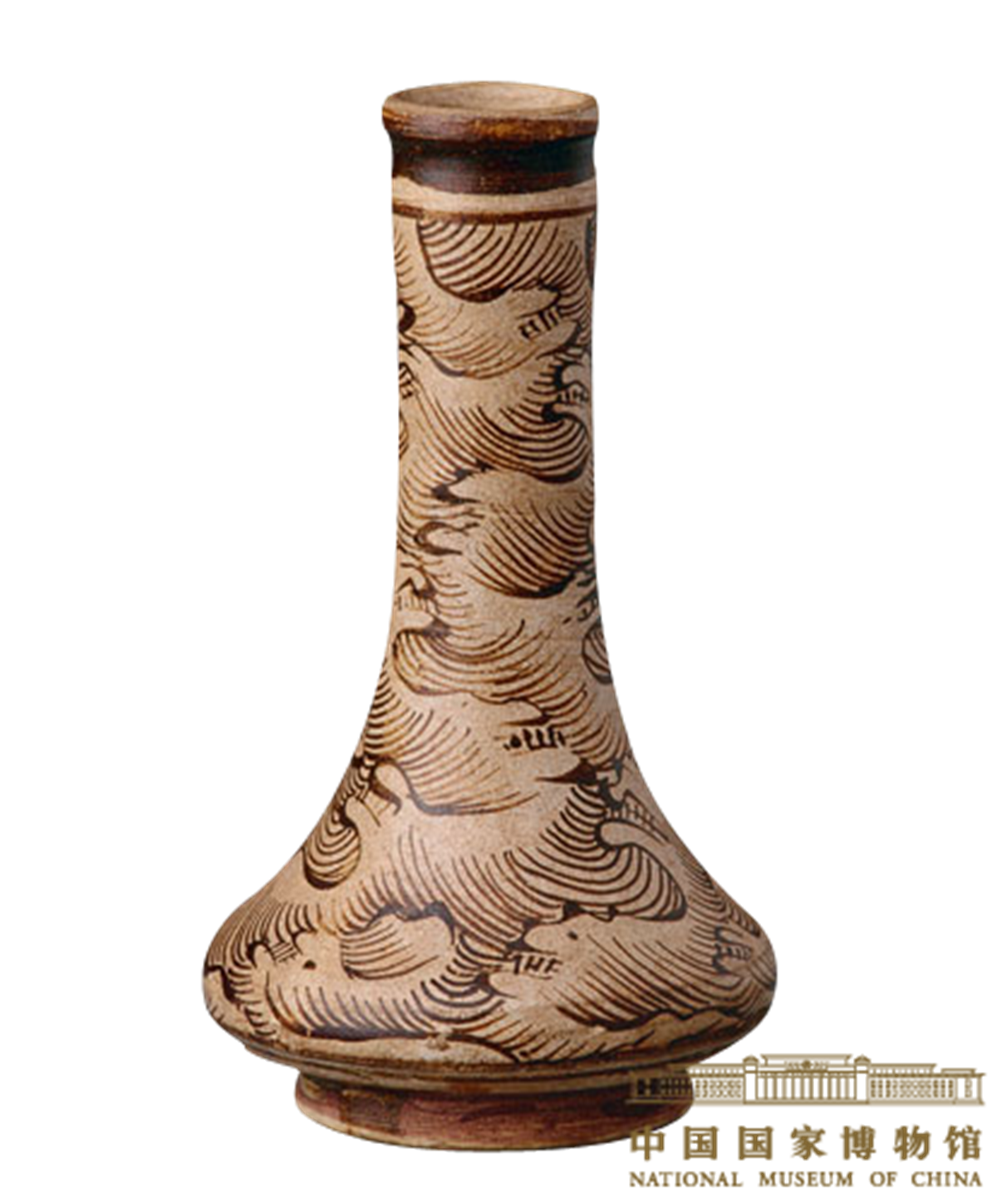
吉州窑是我国宋元时期著名的民间窑场,窑址位于江西省吉安县永和镇。根据文献记载和实地调查,可知吉州窑创烧于晚唐,发展于五代、北宋,极盛于南宋,元代虽仍有烧造,但已渐趋衰落,明代中期又曾有过小规模的短期生产,随之便废弃停烧了。吉州窑是一座同时掌握南、北方著名瓷窑制瓷技艺,生产多种器型、釉色、纹饰产品的综合性瓷窑,其烧造的瓷器品种多样,古朴典雅,富有浓郁的地方风格和民族艺术特色,有“馨香艳丽的山花”之誉。吉州窑产品大致可分为青釉瓷、乳白釉瓷、黑釉瓷、白釉彩绘瓷、绿釉瓷和瓷塑等几个主要品类,此外还有青白釉瓷、碎纹瓷、琉璃器等等,尤以成功烧造于南宋时期的黑釉贴花瓷和白釉彩绘瓷著称于世,在中国和世界的陶瓷发展史上独树一帜。
独特的制瓷工艺
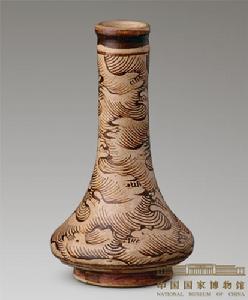
宋 吉州窑彩绘海涛纹瓷瓶 高13.6厘米、口径2.8厘米、底径5.3厘米。
此瓶体薄施白釉,器底露胎,釉下绘酱色波涛纹,造型别致,纹饰生动。吉州窑釉下彩绘是受磁州窑影响而出现的。北宋末年靖康之难,北方地区一些瓷窑遭受一定程度的破坏,磁州窑部分工匠也迁到了安徽、浙江和江西等地继续从事制瓷,因此,吉安吉州窑也烧制了具有磁州窑风格的白地釉下彩绘装饰品种。这种装饰的吉州窑瓷器在墓葬当中也有发现,1970年江西南昌县一座南宋嘉定二年(公元1209年)墓出土了两件釉下彩绘器,一件为三足炉,一件为鹿纹盖罐。1955年安徽省巢县宋墓出土一件酱褐色釉莲花瓶,纹饰画法与上述三足炉主体纹饰荷花纹几乎完全相同,可以肯定也是13世纪初期的吉州窑产品。吉州窑釉下彩绘对景德镇青花瓷器有较大影响,元代后期青花瓷器中的蓝地白花画法即借鉴于吉州窑,元青花、釉里红瓷器回纹边饰也取材于吉州窑,海水的画法与吉州窑之间也有着渊源关系。
吉州窑的瓷土来源于赣江对岸的鸡岗岭和窑场周围,或二者兼而用之。生产场地就在赣江边的沙丘地上,无法避免砂粒进入瓷土,因而胎质中含砂量大,使胎质粗松吸水力强,粗看似陶,但敲之具金属声。这是由吉州窑的生产环境所形成的个性特征,因而成为了区别其他窑口的显著特征。
由于胎泥含砂量高,修胎时往往发生阻刀、跳刀现象,在器底及圈足内能清楚地看见跳刀痕。而胎体表面留下波浪痕经施釉后,其痕迹虽有所减弱,直面观测不易发现,但用手触摸胎表仍可以感受到呈竖条形的起伏,在适当的角度侧视,肉眼可见呈竖条状的釉层挂附不匀等肌理现象。
吉州窯彩繪海濤紋瓷瓶此瓶體薄施白釉,器底露胎,釉下繪醬色波濤紋,造型別致,紋飾生動。
藏品簡介
高:13.6厘米
口徑:2.8厘米
底徑:5.3厘米
用途:盛水具
所處時期:宋
出土時間:1967年
出土地點:江西省南昌市
詳細信息
此瓶體薄施白釉,器底露胎,釉下繪醬色波濤紋,造型別致,紋飾生動。
歷史淵源
吉州窯釉下彩繪是受磁州窯影響而出現的。北宋末年靖康之難,北方地區一些瓷窯遭受一定程度的破壞,磁州窯部分工匠也遷到了安徽、浙江和江西等地繼續從事制瓷,因此,吉安吉州窯也燒制了具有磁州窯風格的白地釉下彩繪裝飾品種。這種裝飾的吉州窯瓷器在墓葬當中也有發現,1970年江西南昌縣一座南宋嘉定二年(公元1209年)墓出土了兩件釉下彩繪器,一件為三足爐,一件為鹿紋蓋罐。1955年安徽省巢縣宋墓出土一件醬褐色釉蓮花瓶,紋飾畫法與上述三足爐主體紋飾荷花紋幾乎完全相同,可以肯定也是13世紀初期的吉州窯產品。吉州窯釉下彩繪對景德鎮青花瓷器有較大影響,元代後期青花瓷器中的藍地白花畫法即借鑑于吉州窯,元青花、釉里紅瓷器回紋邊飾也取材于吉州窯,海水的畫法與吉州窯之間也有著淵源關係。
相關詞條
宋吉州窯彩繪海濤紋瓷瓶
吉州窯彩繪海濤紋瓷瓶,1967年出土於江西省南昌市,為宋代的盛水具,現收藏於中國國家博物館。
参考:苏富比
中國藝術品
03 十二月 2015 • 香港
拍品 229
南宋 吉州窰醬釉蓮花紋長頸瓶
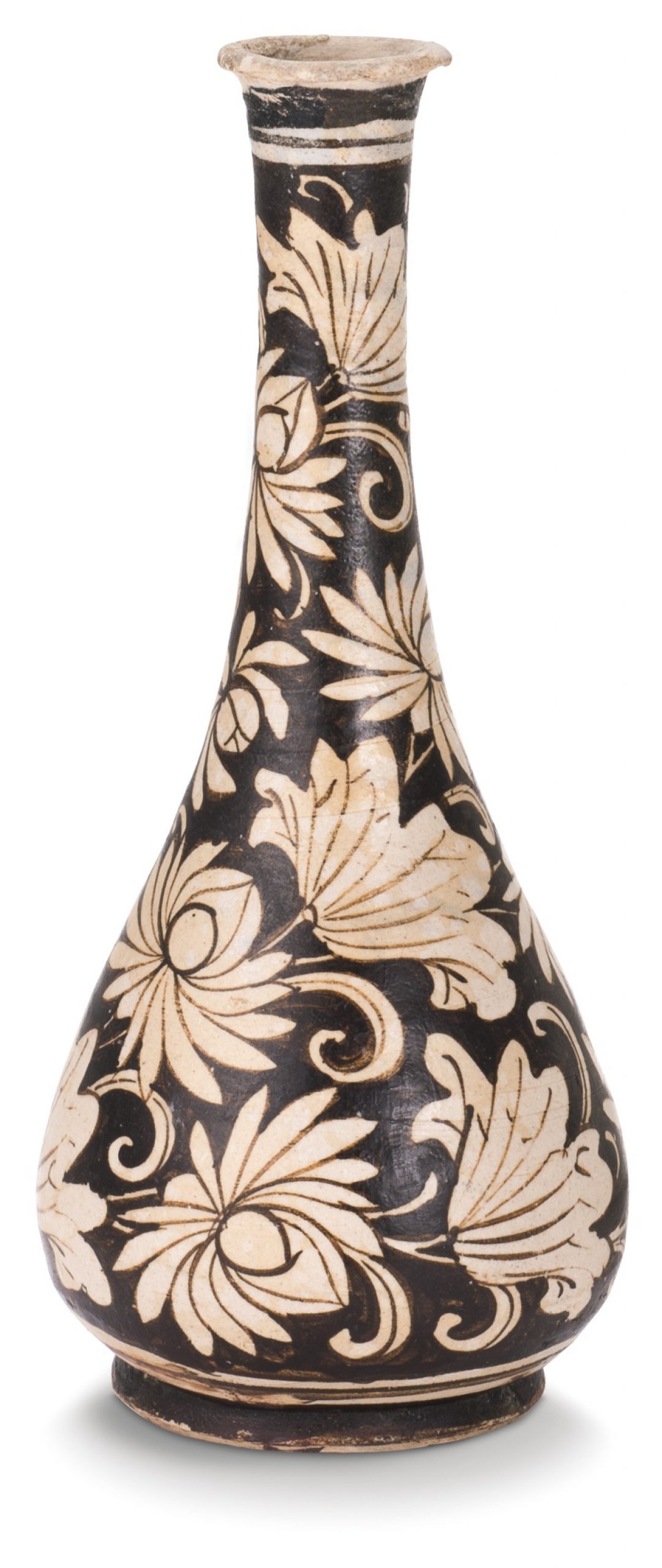
估價 250,000 – 300,000 HKD
已售出 400,000 HKD
描述
ceramic
18.2 公分,3 1/8 英寸
with a bulbous body raised on a wide foot and tapering to a tall neck and an everted mouth, freely painted with a vivid arrangement of lotus flowers and leaves reserved against an opaque glaze of dark brown, the interior and base left unglazed
参考:故宫博物院
元 【磁州窑白地黑花龙凤纹罐】
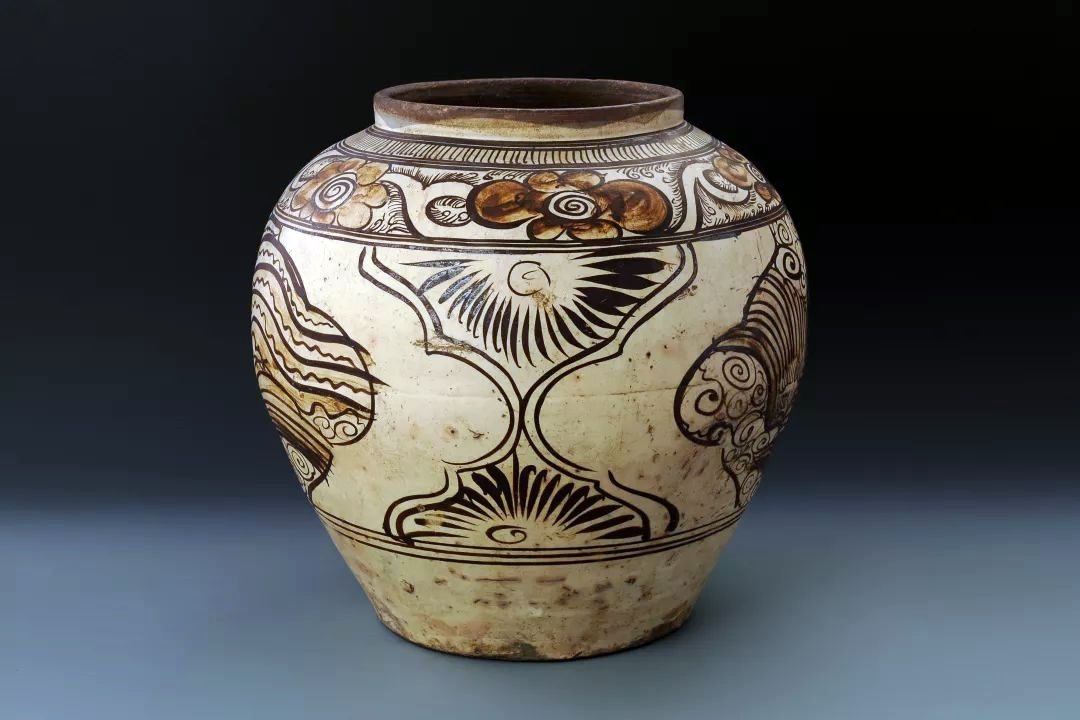
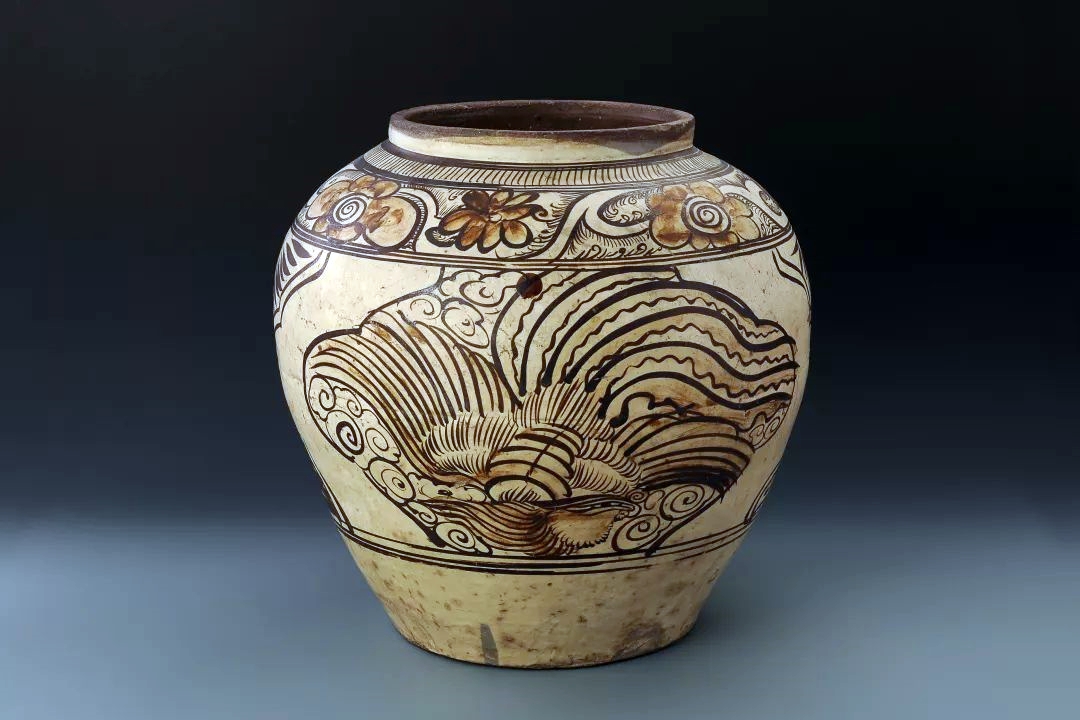
磁州窑白地黑花龙凤纹罐,元,高28厘米,口径16.5厘米,足径13厘米。
罐直口,短颈,丰肩,肩以下渐收敛,圈足。外壁通体白地黑花装饰。其做法是在已成型的坯胎上先施一层洁白的化妆土遮盖住含杂质较多的坯体,然后用毛笔蘸“斑花石”彩料在化妆土上描绘纹饰,肩部绘缠枝菊纹,肩以下至足部描绘龙、凤纹。最后施透明釉,入窑经高温一次烧成。
撰稿人:吕成龙
关键词: 磁州窑 白地黑花 化妆土 斑花石 缠枝
参考:廊坊博物馆 元 磁州窑白地黑花云凤纹大罐
磁州窑是我国古代北方著名窑场,其独特的装饰手法,活泼的生活情趣,鲜明的艺术风格,深受世人喜爱。廊坊博物馆收藏的一件白地黑花云凤纹大罐即为元代磁州窑产品中的佳作。
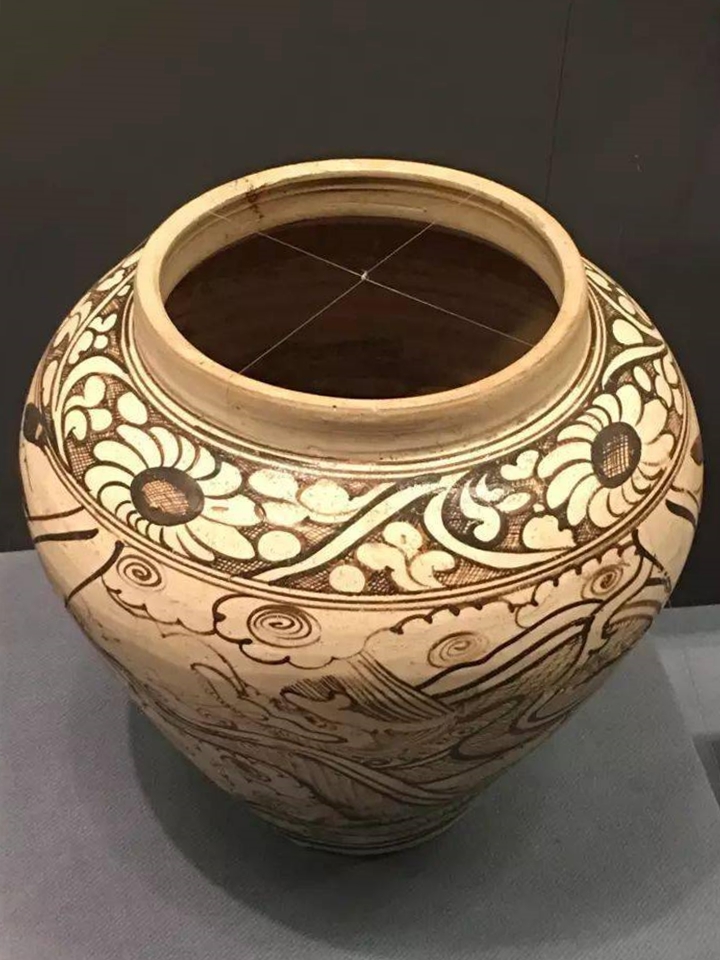
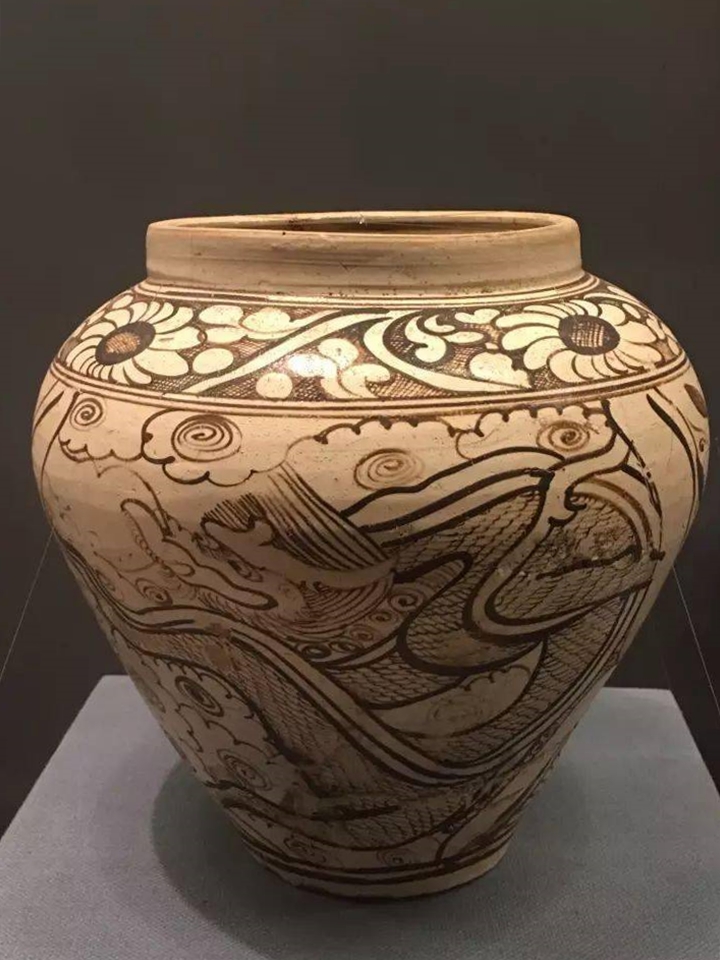
该罐口径25厘米、底径26.8厘米、高44厘米,直口,广肩,鼓腹,平底。通体以三道一组的褐彩弦纹隔为三组装饰纹带,颈下部为一周排列规整的直线条纹,肩上绘海水江牙及牡丹纹,为传统纹样中的“落花流水”。器身主体装饰为对称的两面开光,开光内绘两只凤鸟,昂首引颈,双翅平展,尾部弯曲作飘拂状,凤鸟周围填数朵祥云,开光间饰上下对称的草叶纹。整体构图严谨,主题突出,表现手法雄浑泼辣,动感强烈,给人以凤翔天宇、鸣嗥九霄之感。
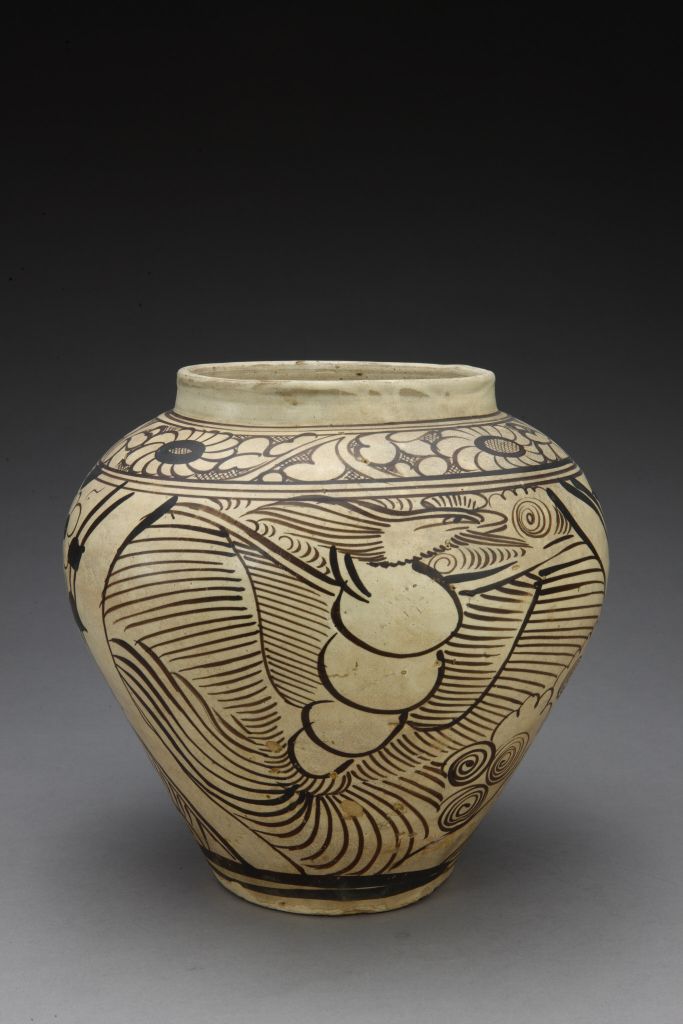
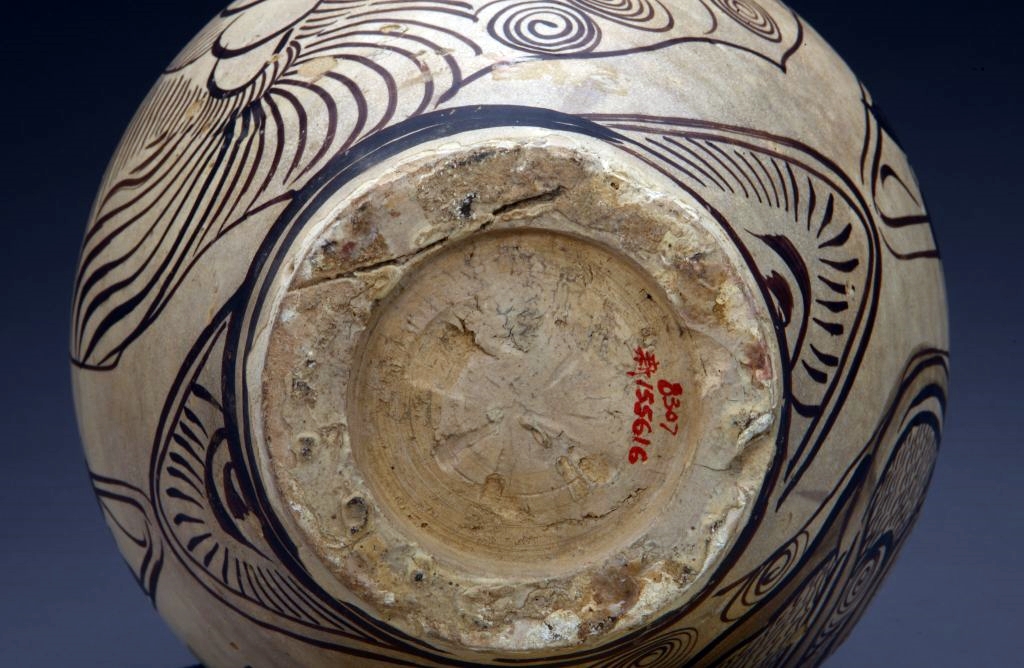
磁州窑初创于五代末、北宋初,金代中后期达到鼎盛,在器物种类、釉色、装饰技法、纹饰图案方面都达到高峰,磁州窑最具特色的装饰手法——白地黑花也在这一时期发展成熟。元代以后,磁州窑走向衰落,表现为产品种类单调,质量下降,但数量大大增加,销地也更为广泛。该罐正是这一时期产品,其胎体厚重,胎质粗糙,通体施乳白釉,白中泛黄,光泽较差,釉厚薄不匀,局部出现深浅不一的褐色斑痕,这些均属元代磁州窑产品的特征。但其体型硕大,绘画洒脱飘逸,仍不失为磁州窑产品中的上品。七十年代初北京元大都遗址曾出土一件磁州窑凤纹罐,形制、纹饰与其基本相同,表明这类器物似乎与皇家使用有关。
磁州窑黑花瓷双凤罐
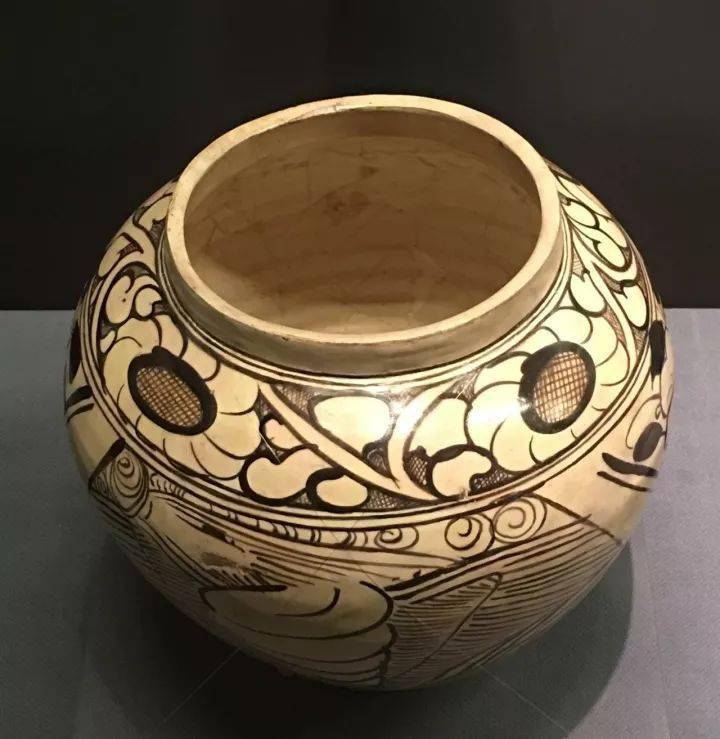
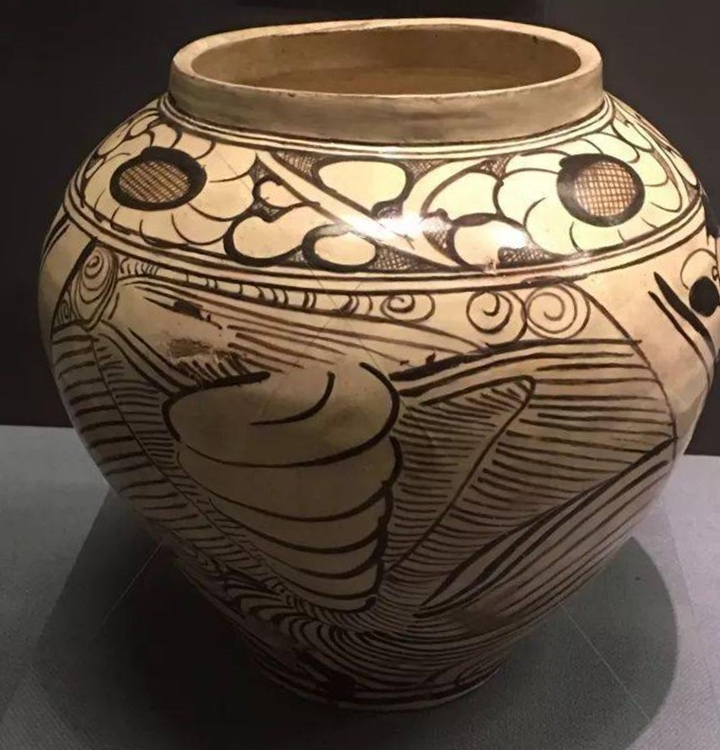
参考:苏富比
Chinese Art
02 六月 2016 • 香港
拍品 665
宋至金 磁州窰白地黑花纏枝花繪紋梅瓶
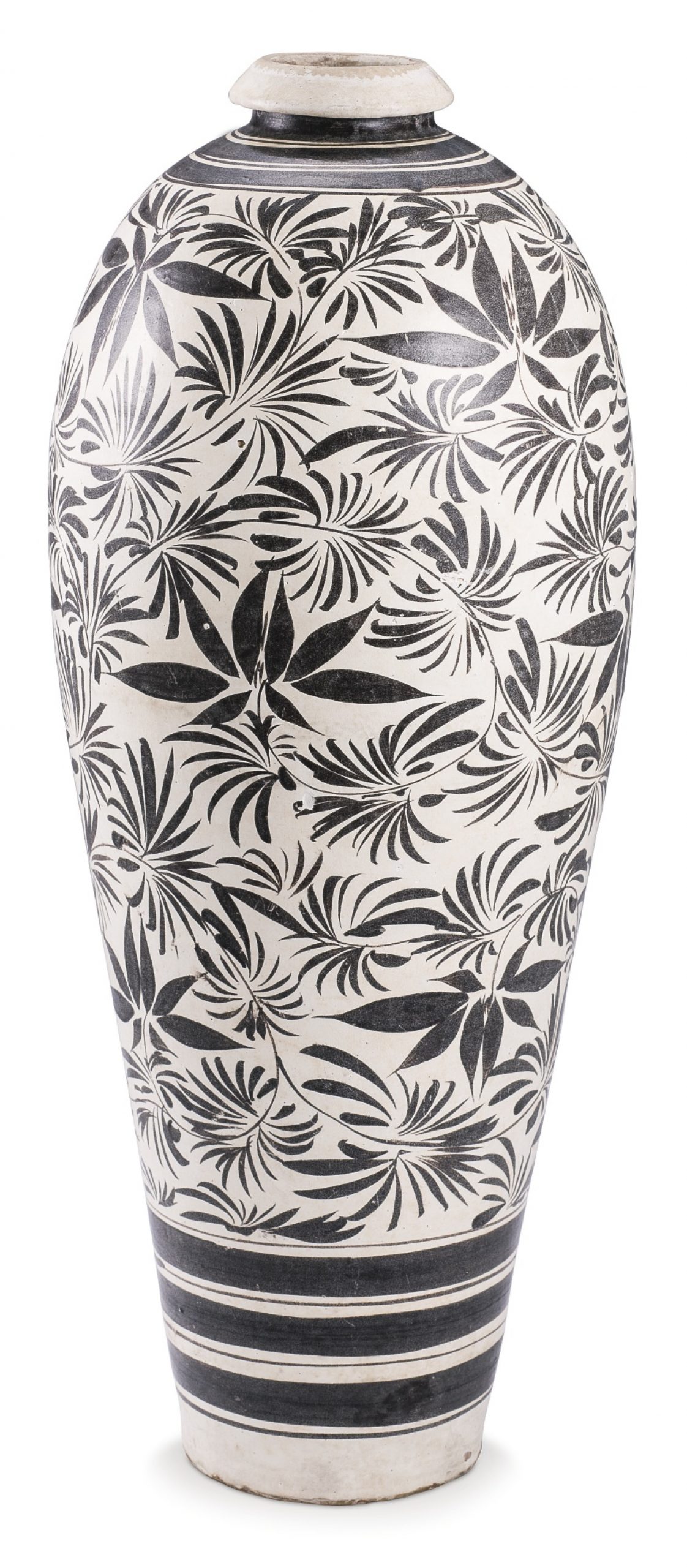
估價 300,000 – 400,000 HKD
已售出 2,000,000 HKD
描述
ceramic
43.5 公分,17.5 英寸
elegantly potted, of slender meiping form, the exterior freely and boldly decorated in black over a white slip with floral blooms borne on leafy stems meandering across the vessel, all between horizontal bands encircling the neck and lower body
拍品資料及來源
本品碩美,列傳世磁州窰之大器,白地黑彩互為映襯,對比鮮明,令人印象深刻。相若器形繪黑彩紋飾者甚罕,僅於少數世界知名收藏個例可見,然其尺寸、造型及紋飾各異。故此例梅瓶可謂獨一無二。
相近造形及紋飾者似僅兩例。一例屬日本收藏,尺寸略小,錄於《陶磁全集13:宋の磁州窰》,東京,1958年,圖版33,後展並刊於衰豊,《Freedom of Clay and Brush Through Seven Centuries in Northern China: Tz’u-chou Type Wares 960 – 1600 A.D》,印第安納波利美術館,印第安納波利,1980年,圖179。編者言,此類造形器,用於盛酒,於十二至十四世紀燒造於不同窰口。然此類器常飾枝葉紋,其筆觸纖柔,由中心外散,為河南禹縣窰口紋飾之典型。另一例,其肩上部飾蓮葉紋一周,載於《白と黒の競演―中國磁州窰系陶器の世界》,大阪市立美術館,大阪,2002年,圖錄81。亦可比一較小梅瓶例,造形相異,售於紐約蘇富比1986年3月12日,編號235。
有相類梅瓶數例,可資參考,飾相類枝葉紋樣,然其紋以彩繪線紋平行相隔。北京故宮博物院藏有兩例,分別錄於《中國陶瓷全集》,上海,1999-2000年,卷7,圖版201及《故宮博物院藏文物珍品全集.兩宋瓷器(上)》,香港,1996年,圖版152(圖一)。另存一例,日本政府將其定為重要藝術品,刊於《白と黒の競演―中国磁州窰系陶器の世界》,前述出處,編號82。堪萨斯城納爾遜阿特金斯藝術館亦藏一例,可作比較,錄於衰豊,前述出處,編號68。亦比一例,藏於東京出光美術館,圖載《中國磁州窯なごみと味わい》,東京出光美術館,東京,2005年,編號3,以及一例,售於倫敦蘇富比1986年6月10日,編號163。
参考:宋 磁州窑,开光人物花卉纹罐
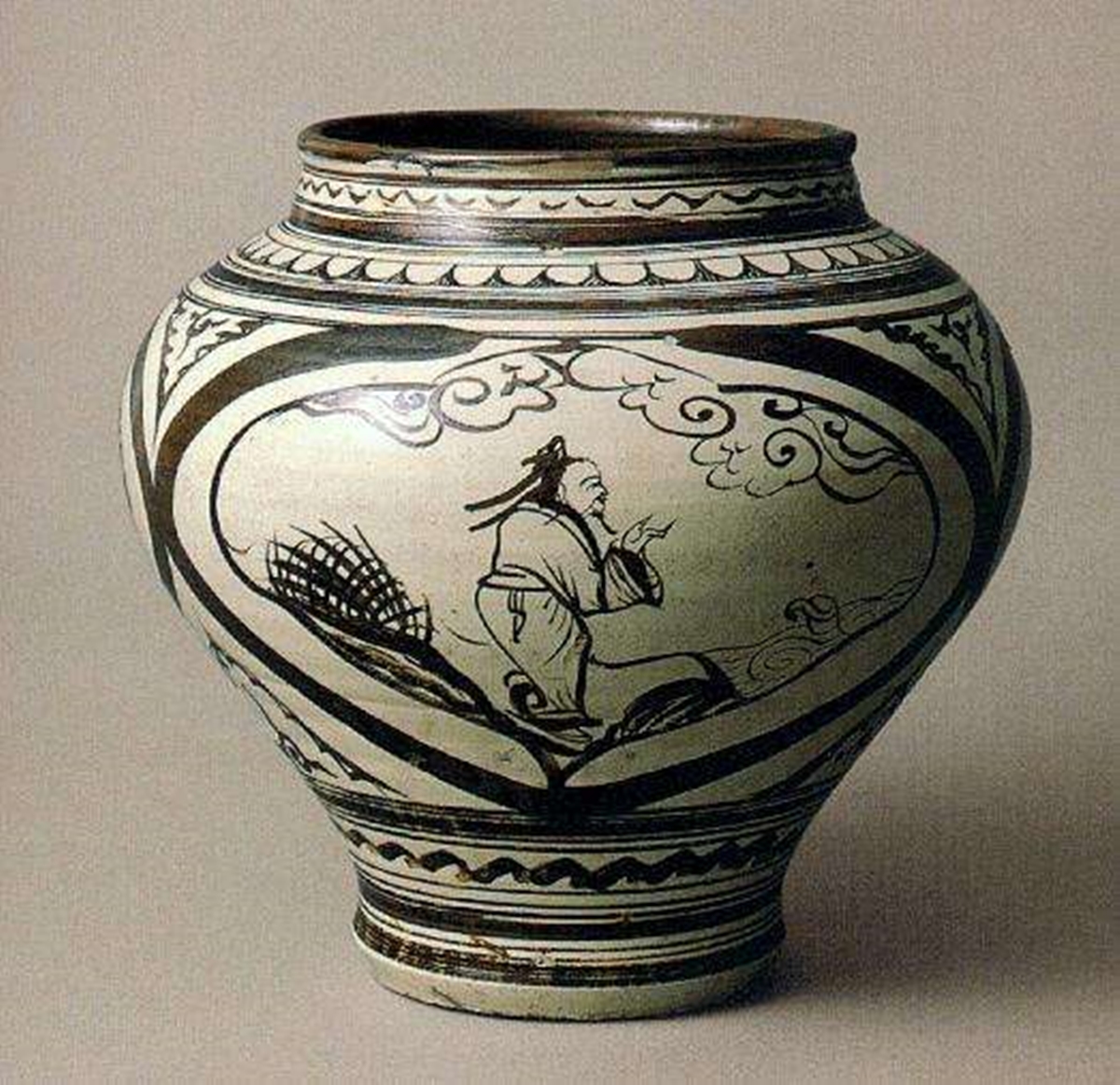
参考:南宋吉州窑白地黑花绘海水奔鹿纹三足炉
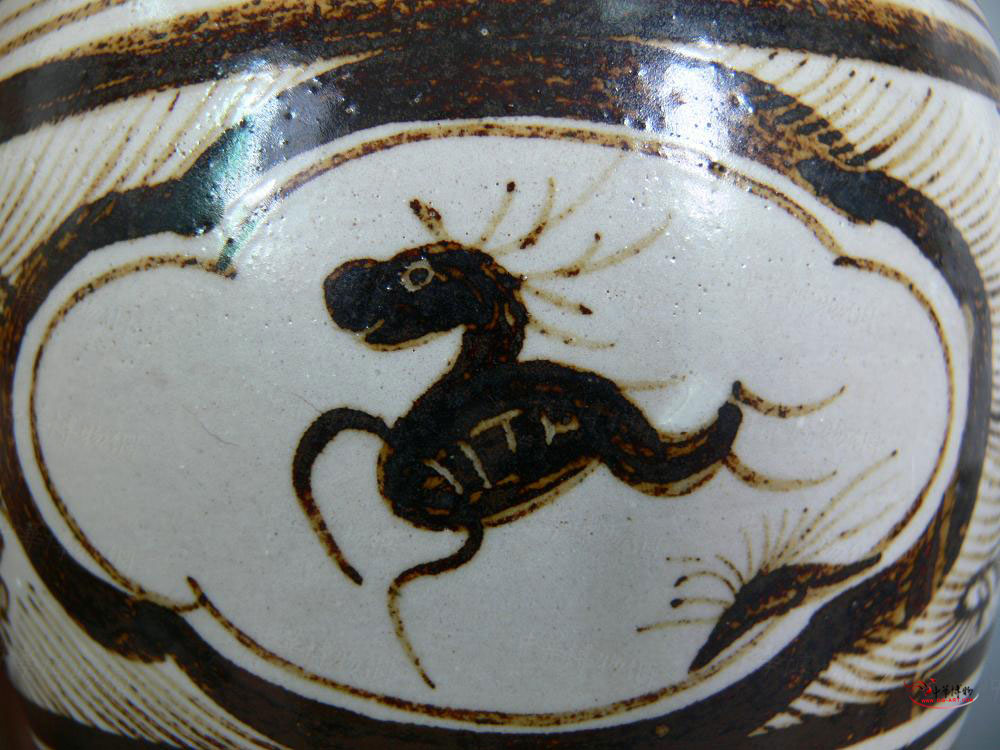
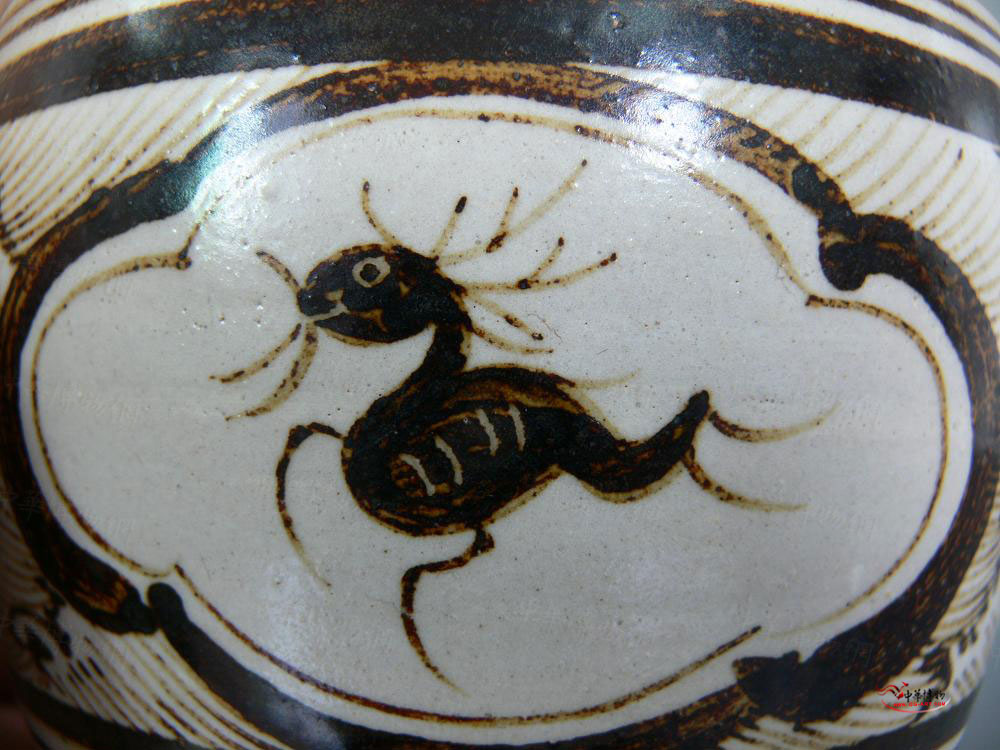
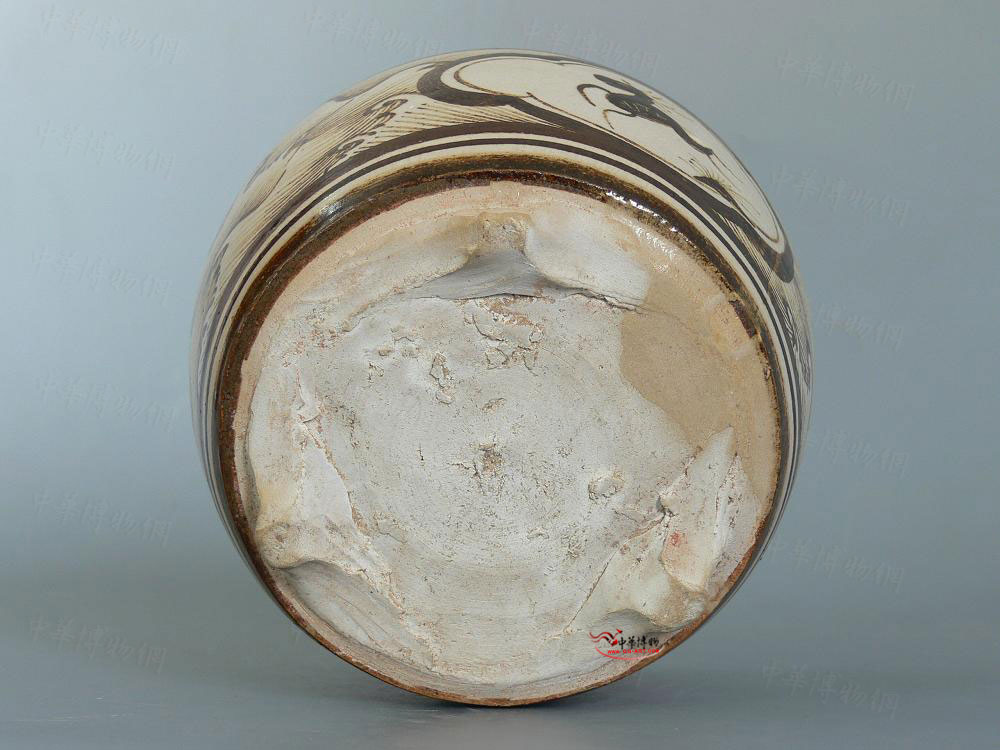
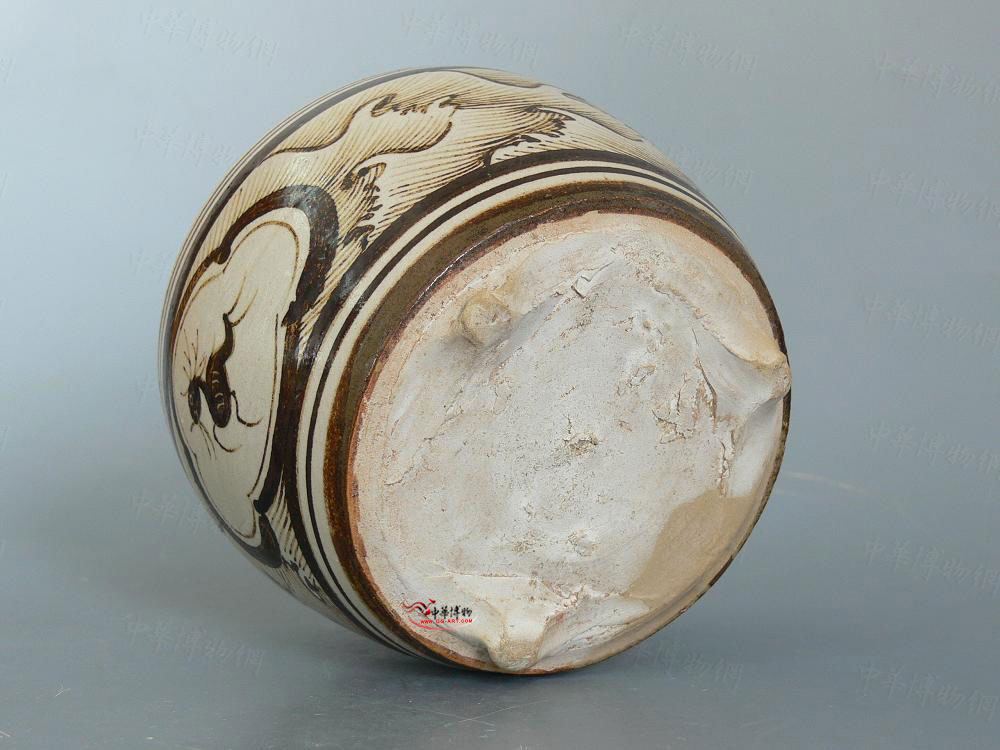
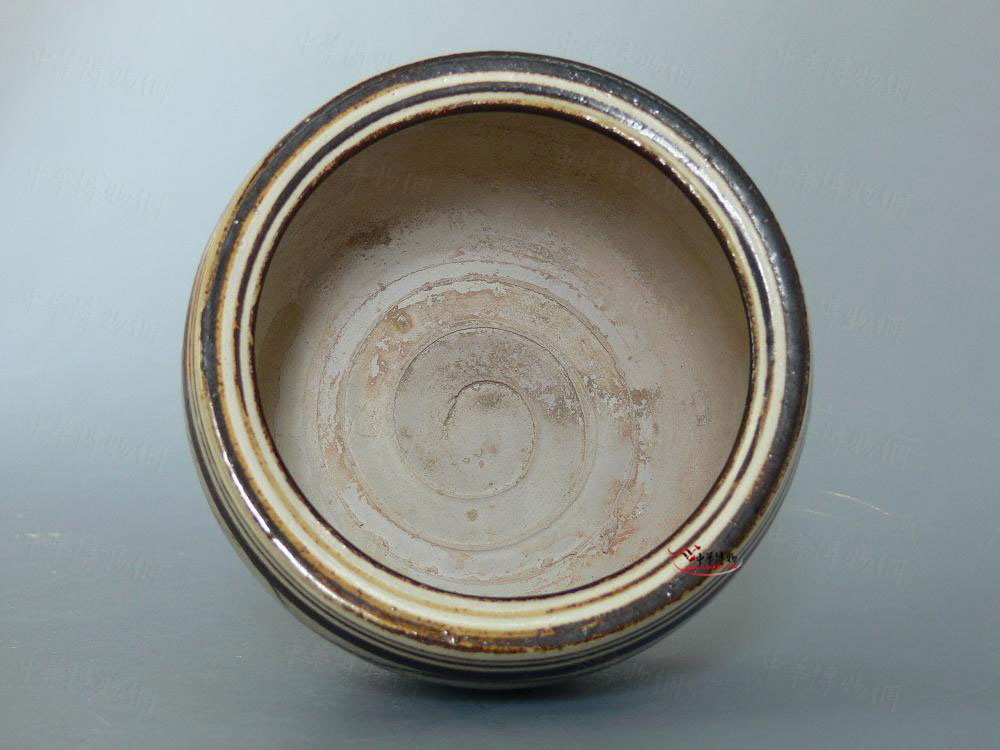
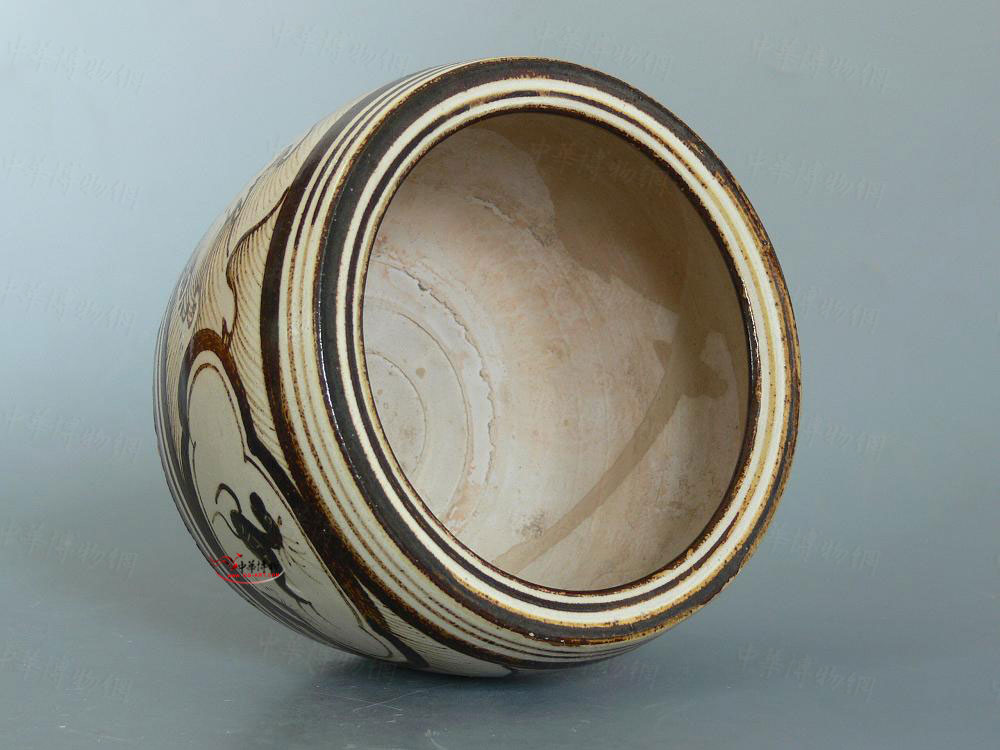
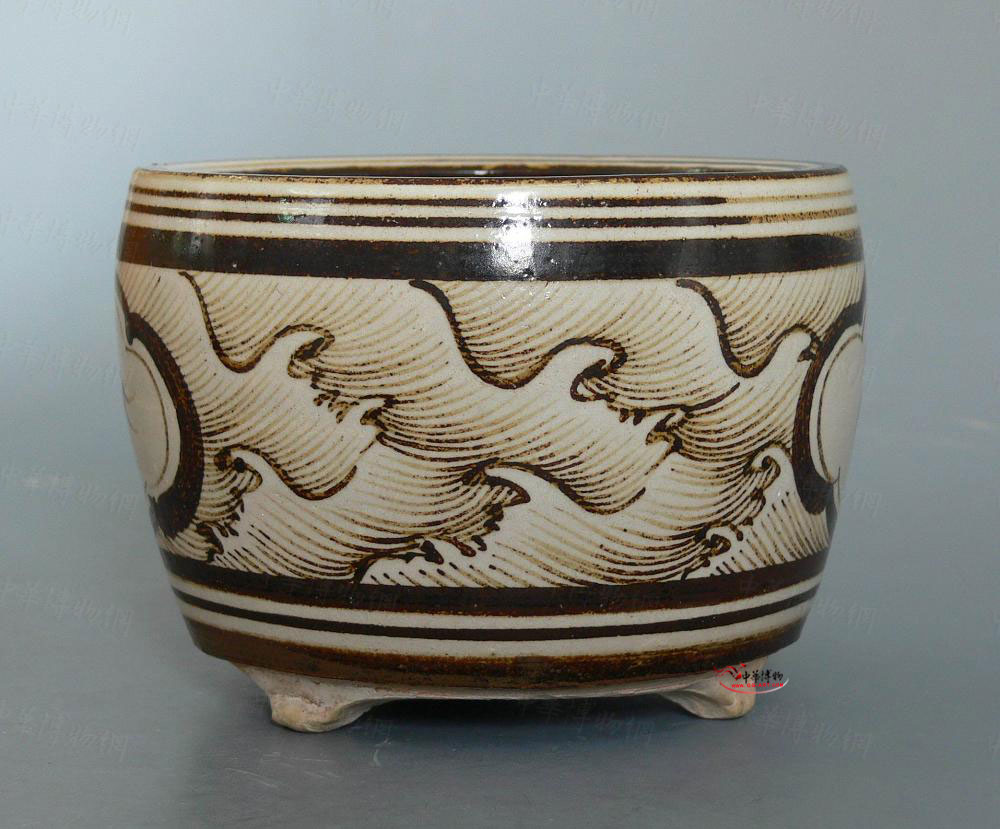
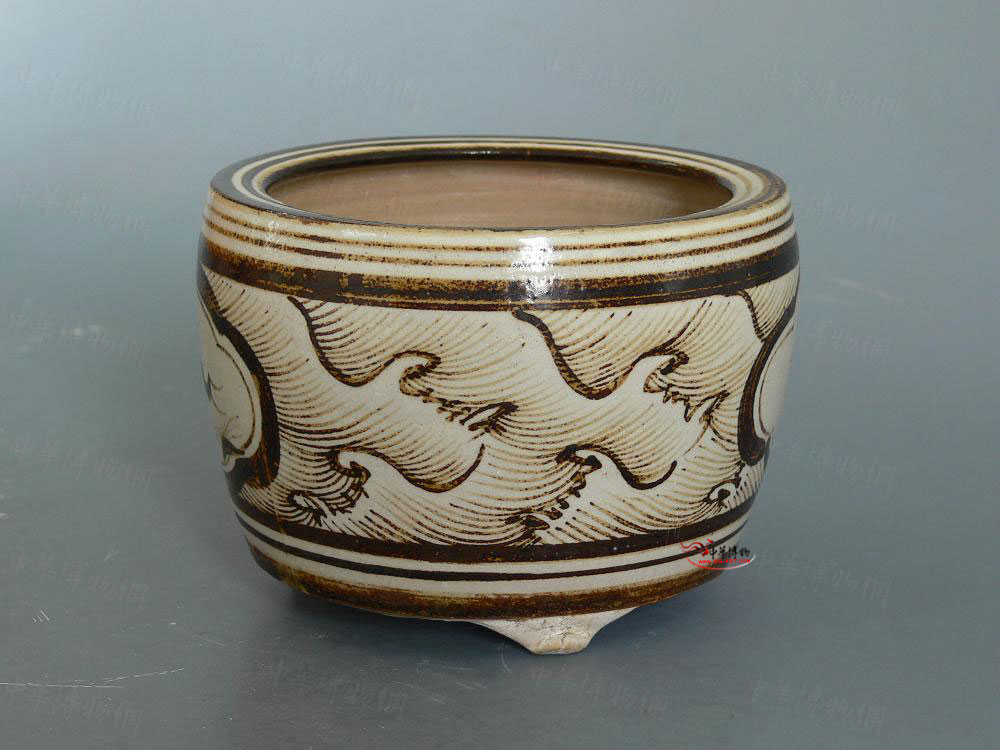
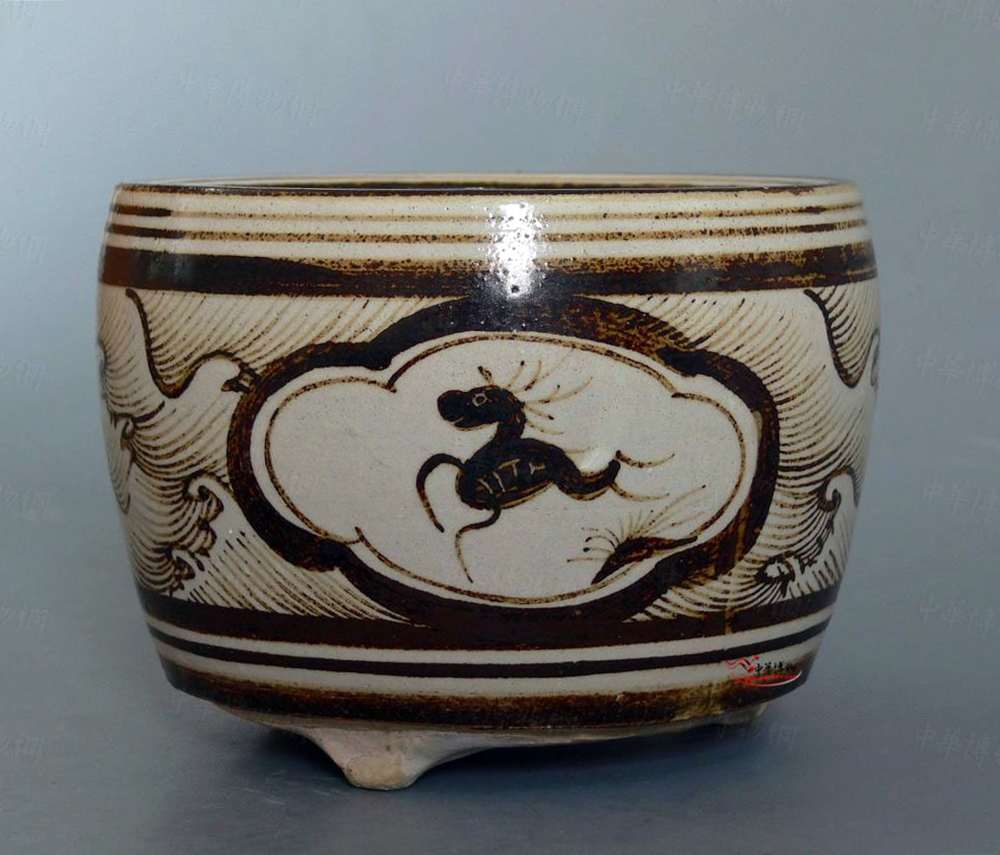
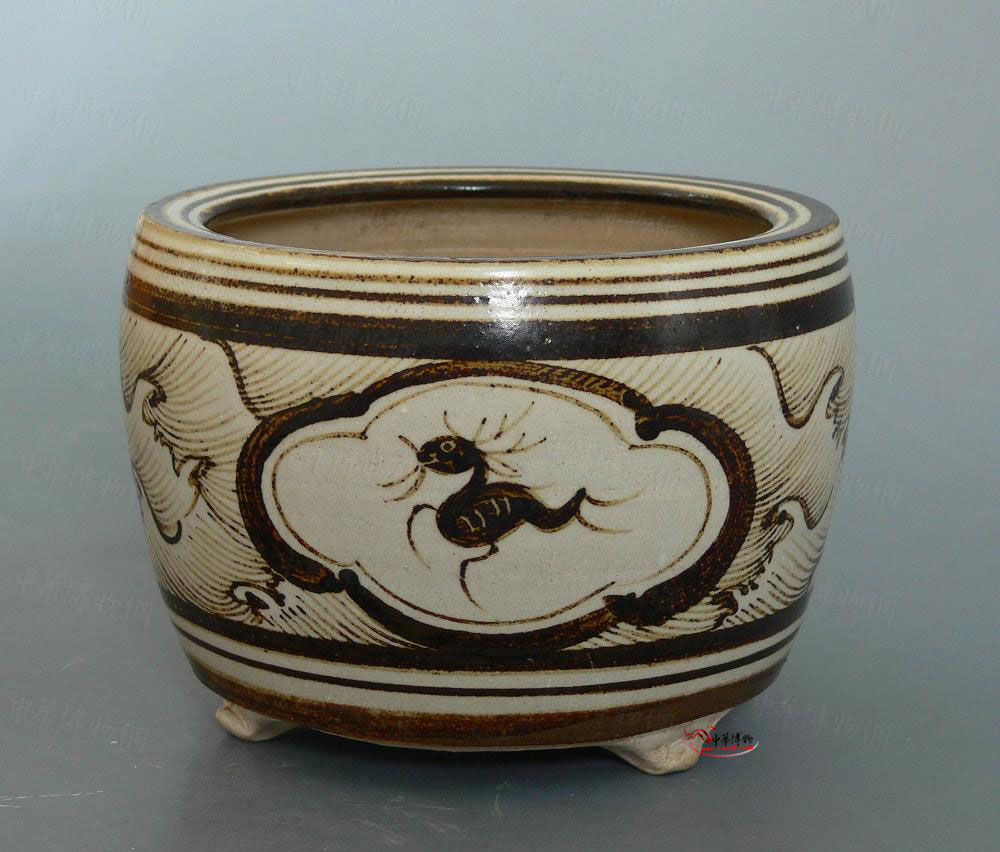
此件为典型吉州窑产品。高9.8厘米,口径12.9厘米。圆唇,平沿内折,筒形腹略鼓,平底,矮三足。胎质灰白细腻,彩绘海水纹,两开窗,内画奔鹿,外罩稀薄之透明白釉。辅助文饰细致规正,主题文饰潇洒灵动,充分表现了吉州窑工匠们娴熟的瓷绘技巧。 1970年江西省南昌市南宋“嘉定二年”(公元1209年)墓曾经出土过一件造型相同,文饰稍异的三足炉,因此该件定为南宋器是妥当的。
参考:中国嘉德国际拍卖有限公司
中国嘉德香港2017秋季五周年庆典拍卖会
搏泥幻化—中国古代陶瓷
2017-10-02
0001 南宋(1127~1279) 吉州窑釉下墨彩花鸟纹小长颈瓶
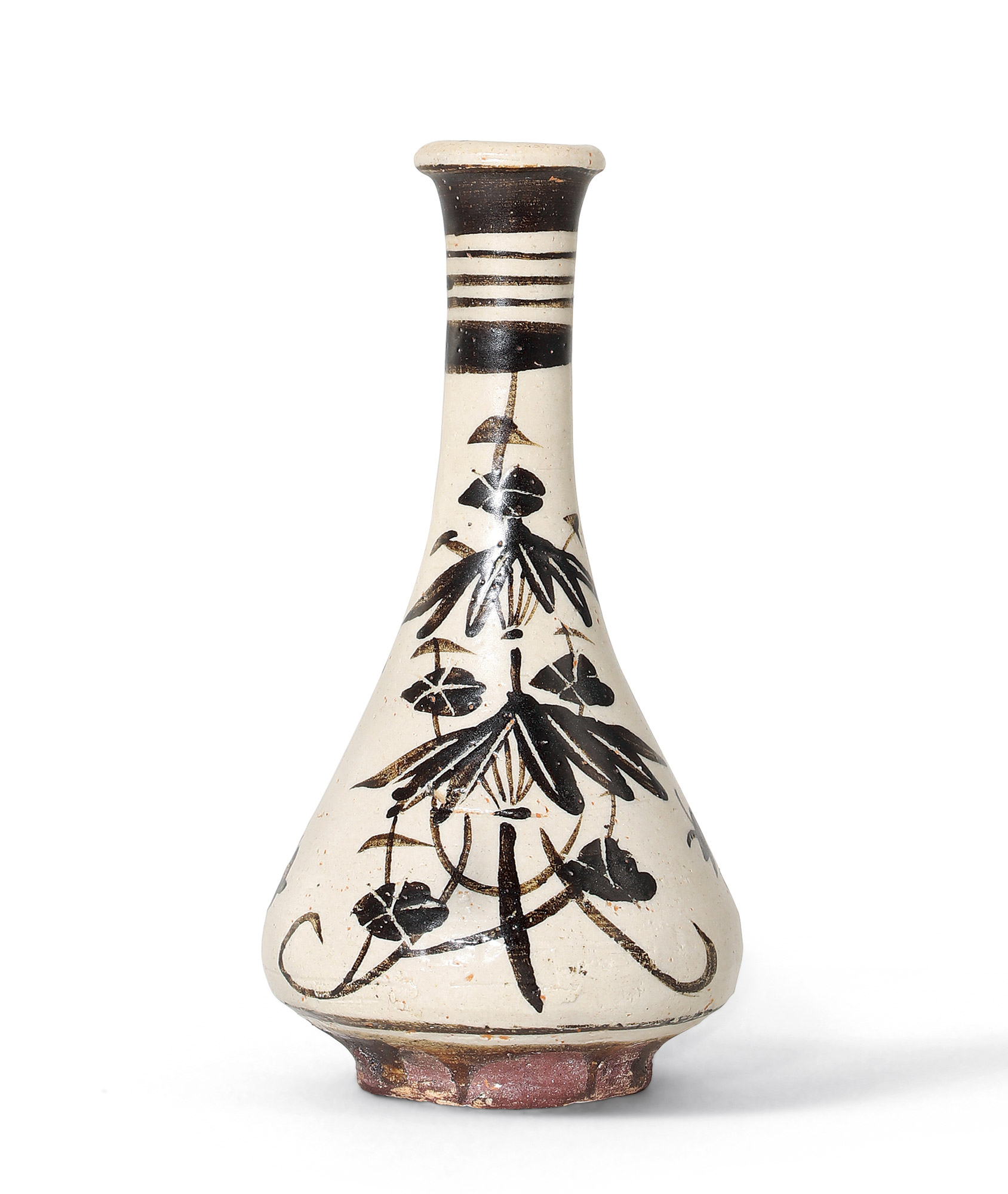
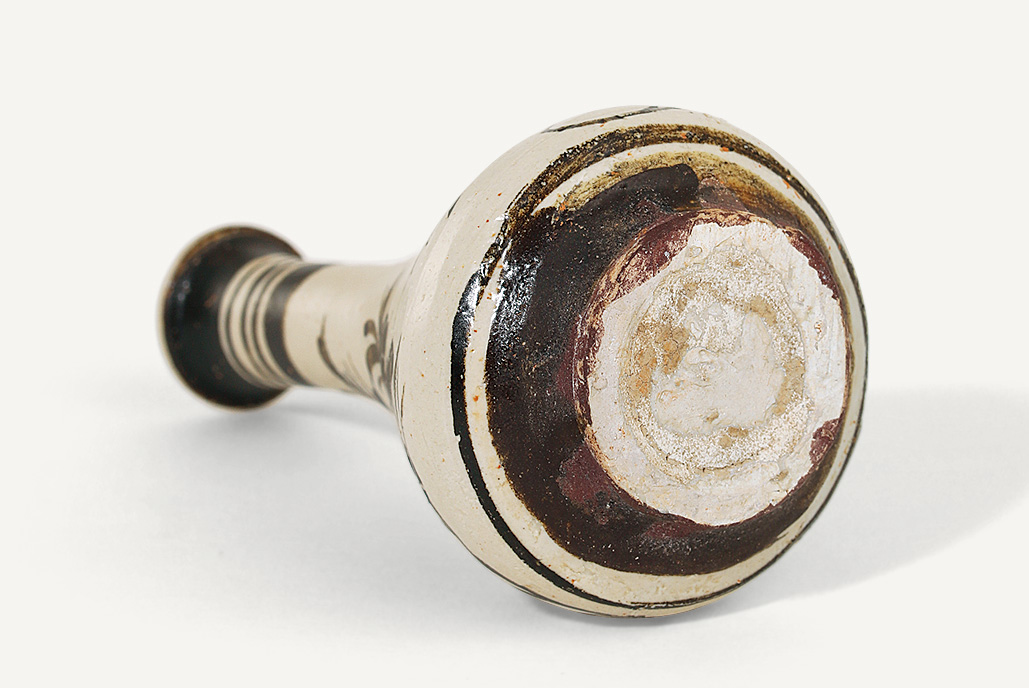
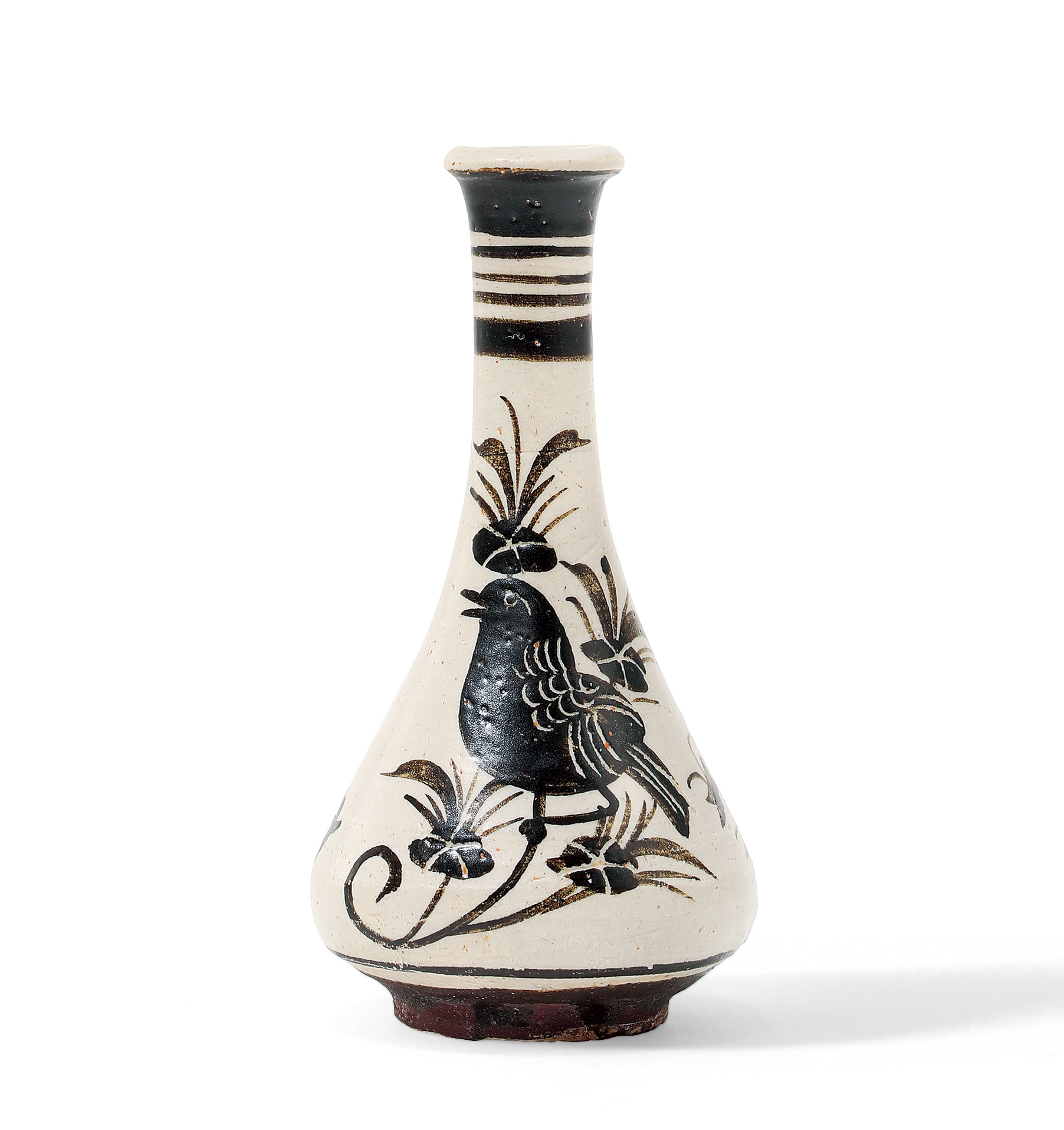
拍品信息
估价 HKD 15,000-25,000
成交价 RMB 58,764HKD 70,800USD 9,062EUR 7,080
尺寸 口径2.1cm;足径3.3cm;高10.8cm
说明
吉州窑产品中的长颈瓶、梅瓶等经常在腹部彩绘折枝花鸟图案,此类图常被人冠以桃花喜鹊、梅花喜鹊、雀梅纹等名。按深圳博物馆郭学雷先生考究,称其为「海棠啼莺」更为准确。「此类折枝花叶呈略尖的长椭圆形(梅花开花时无叶),花朵着意表现五枚椭圆形花瓣之间的交叠现象(梅花、桃花五瓣花无交叠),而且花朵均有细长花梗(梅花、桃花均无细长花梗),具典型的垂丝海棠特征。其鸟纹小巧、圆润丰满的特点,也明显与长尾的喜鹊不同,倒是与莺科类的体态颇为一致。」<1>综上,所谓的「桃花」、「梅花」应为海棠,「喜鹊」应为莺,因为莺均作啼鸣状。
小瓶精致小巧,唇口外折,细长颈,垂鼓腹,假圈足,足心浅挖。足底涩胎,足墙刷饰棕褐色护胎釉。胎土淘洗细,具粉质感,色灰白。器身釉下墨彩绘海棠啼莺纹,蝴蝶点缀,弦纹相辅,画工精湛。纹饰细节处,如花叶脉络、毛羽等,复以刻划工艺强调,最后施透明釉烧成。整器除釉面偶见细小棕眼、一处缩釉外,品相完整。
参考:苏富比
Chinese Art
02 六月 2016 • 香港
拍品 650
宋至元 吉州窰海浪紋罐
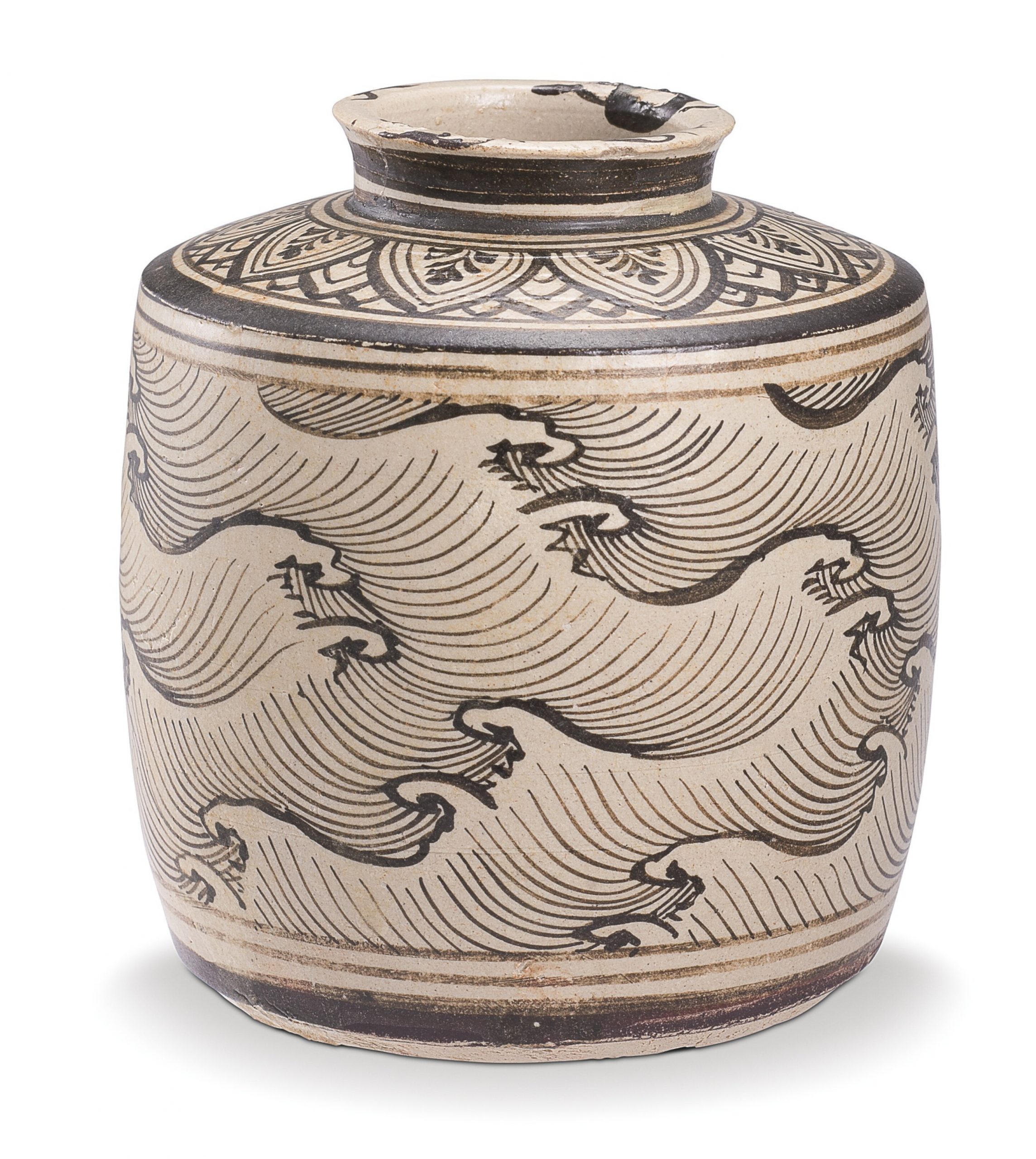
估價 200,000 – 300,000 HKD
描述
ceramic
11.3 公分,4 1/2 英寸
of cylindrical section resting on a countersunk base, with sharply angled shoulders below the galleried rim, the buff-coloured body painted in dark brown with cresting waves and with overlapping petals radiating around the mouth, covered all over in a transparent glaze
拍品資料及來源
吉州窰為宋元時期最著名的瓷窰之一,與佛教禪宗也有較密切的關聯,本件拍品小巧可愛,花紋畫工精彩,可能是吉州窰孤品。本瓶所繪波濤紋是吉州窰最出色最具代表性的紋飾之一,見於吉州窰各類器物,但本品器形則甚為罕見。倫敦蘇富比曾出售一件吉州窰瓶,通體繪極為類似的波濤紋,器形接近,但瓶身遠比本拍品修長,高為二倍多,售於1980年11月7日,編號119。另有一件器形與波濤紋及尺寸類似倫敦蘇富比售出者,但波濤紋之間繪有三個開光,內繪人物紋,肩部繪有類似本拍品的蓮瓣紋,售於紐約佳士得2012年3月23日,編號1972。玫茵堂收藏一件,器形與本拍品稍更接近,肩部飾類似蓮瓣紋,但腹部僅繪花鳥紋以及蕉葉紋,見康蕊君,《玫茵堂中國陶瓷》,倫敦,1994-2010年,卷1,編號 519。類似本拍品的波濤紋,也見於吉州窰其它形式器物上,例如長頸瓶,一件藏於中國國家博物館,見展覽圖錄《吉州窰》,中國國家博物館,北京,2004年,頁70;一件售於倫敦蘇富比1990年6月12日,編號179。另可比較兩件重要波濤紋瓷器殘件,皆為寺廟供器,一件為吉州窰址出土罐,用褐彩書有干支紀年丁未歲,當為元大德十一年(1307),見彭明翰,《雅俗之間:吉州窰》,北京,2007,圖版67;另一件為凈水缽,褐彩書有至元己卯年題記,當為1279年,見展覽圖錄《禪風與儒韻:宋元時代的吉州窰瓷器》,深圳博物館、深圳市文物考古鑒定所等,深圳,2012年,編號107。
参考:佳士得
25 11月 2014 | 現場拍賣 3371
重要中國瓷器及工藝精品
拍品 3229 北宋 磁州窑莲纹玉壶春瓶
A CIZHOU SGRAFFIATO ‘LOTUS’ PEAR-SHAPED VASE, YUHUCHUNPING
NORTHERN SONG DYNASTY (960-1127)
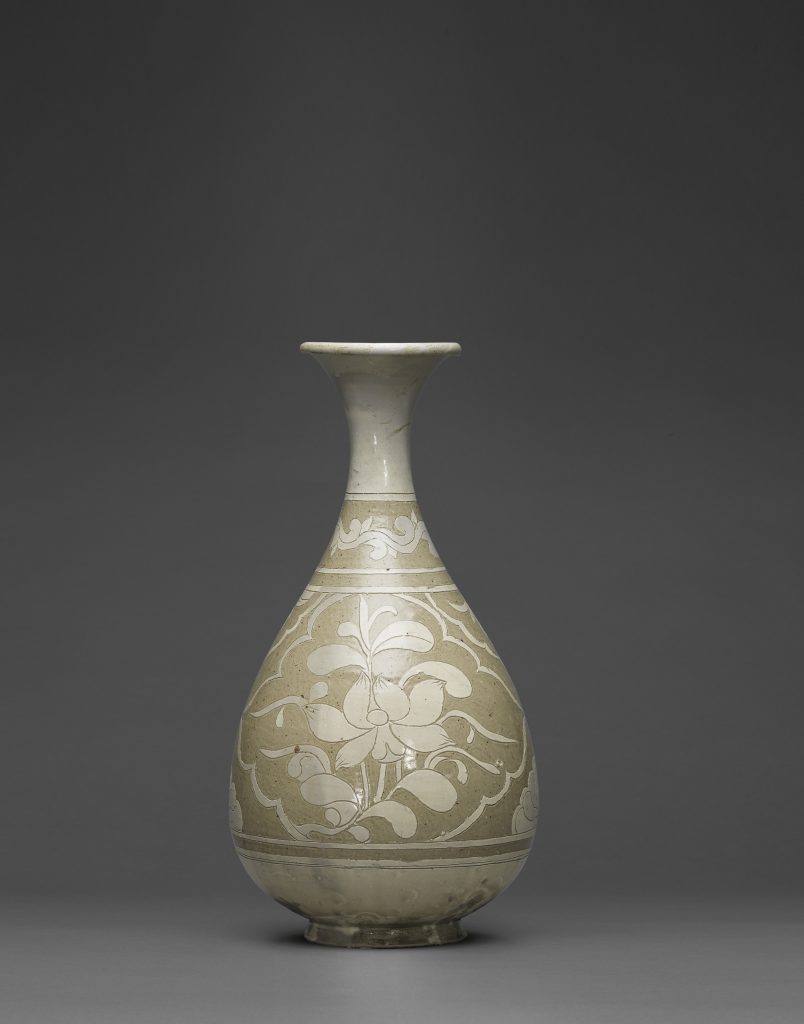
成交價HKD 375,000
估價HKD 300,000 – HKD 500,000
細節
A CIZHOU SGRAFFIATO ‘LOTUS’ PEAR-SHAPED VASE, YUHUCHUNPING
NORTHERN SONG DYNASTY (960-1127)
The elegantly potted vase is freely carved through the white slip to the buff body with a wide band of shaped panels enclosing a lotus spray, separated by a cartouche enclosing a leaf decoration above a chrysanthemum, all below a band of scrolling foliage.
12 3/8 in. (31.5 cm.) high
狀況報告
– There is a chip measuring approx. 3 cm. wide and a few other shallow nicks to the foot.
– There are scratches and wear to the surface as can be expected.
– Two small holes have been drilled on the inner foot for TL testing.
拍品專文
Cizhou sgraffiato vases of this yuhuchunping shape with the decoration carved through a white slip rather than the dark brown glaze appear to be quite rare. One of similar type, also with the decoration arranged in bands around the body and neck, is illustrated in Song Ceramics from the Kwan Collection, Hong Kong Museum of Art, 1994, no. 197.
The result of Oxford Authentication thermoluminescence test no. P102e80 is consistent with the dating of this lot.
参考:佳士得
拍賣 12175
中國瓷器及工藝精品
紐約|2016年9月16日
拍品1313
南宋/元 吉州窯小膽瓶
SOUTHERN SONG/YUAN DYNASTY, 12TH-14TH CENTURY
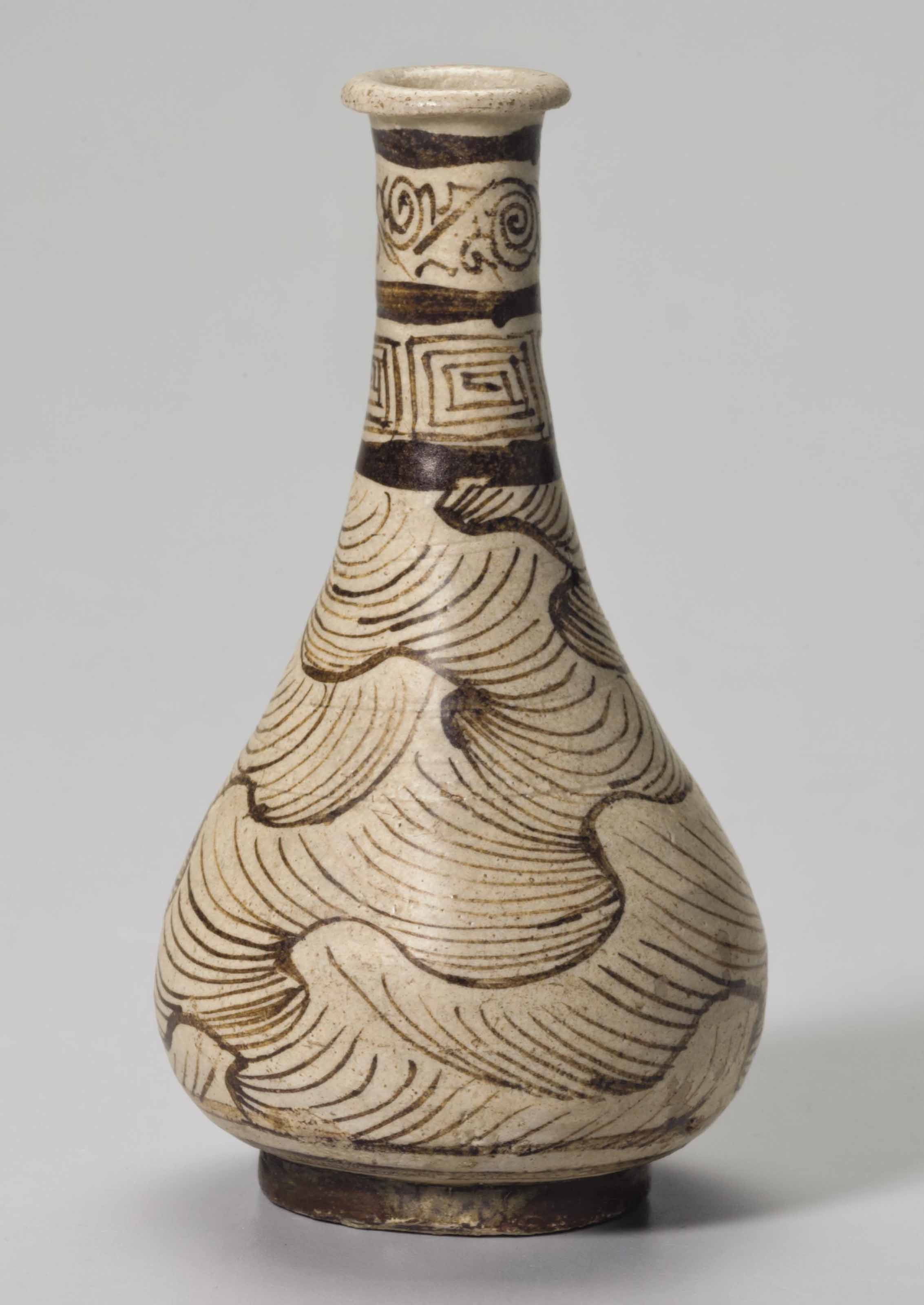
南宋/元 吉州窯小膽瓶
成交總額USD 27,500
估價USD 4,000 – USD 6,000
南宋/元 吉州窯小膽瓶
3 7/8 in. (9.9 cm.) high
來源
Blitz Antiek en Kunsthandel, Amsterdam.
拍品專文
A vase with similar wave design was sold at Christie’s New York, 22-23 March 2012, lot 1972. Another vase of miniature form with wave design throughout is located in the Jiangxi Provincial Museum and illustrated by J. C. Watt in The World of Khubilai Khan: Chinese Art in the Yuan Dynasty, New York, 2010, p. 277, fig. 307.
参考:佳士得
拍賣 13755 開元大觀
香港 2016年 6月 1日
Lot 3123 北宋 金 磁州窑绿釉剔花牡丹纹瓶
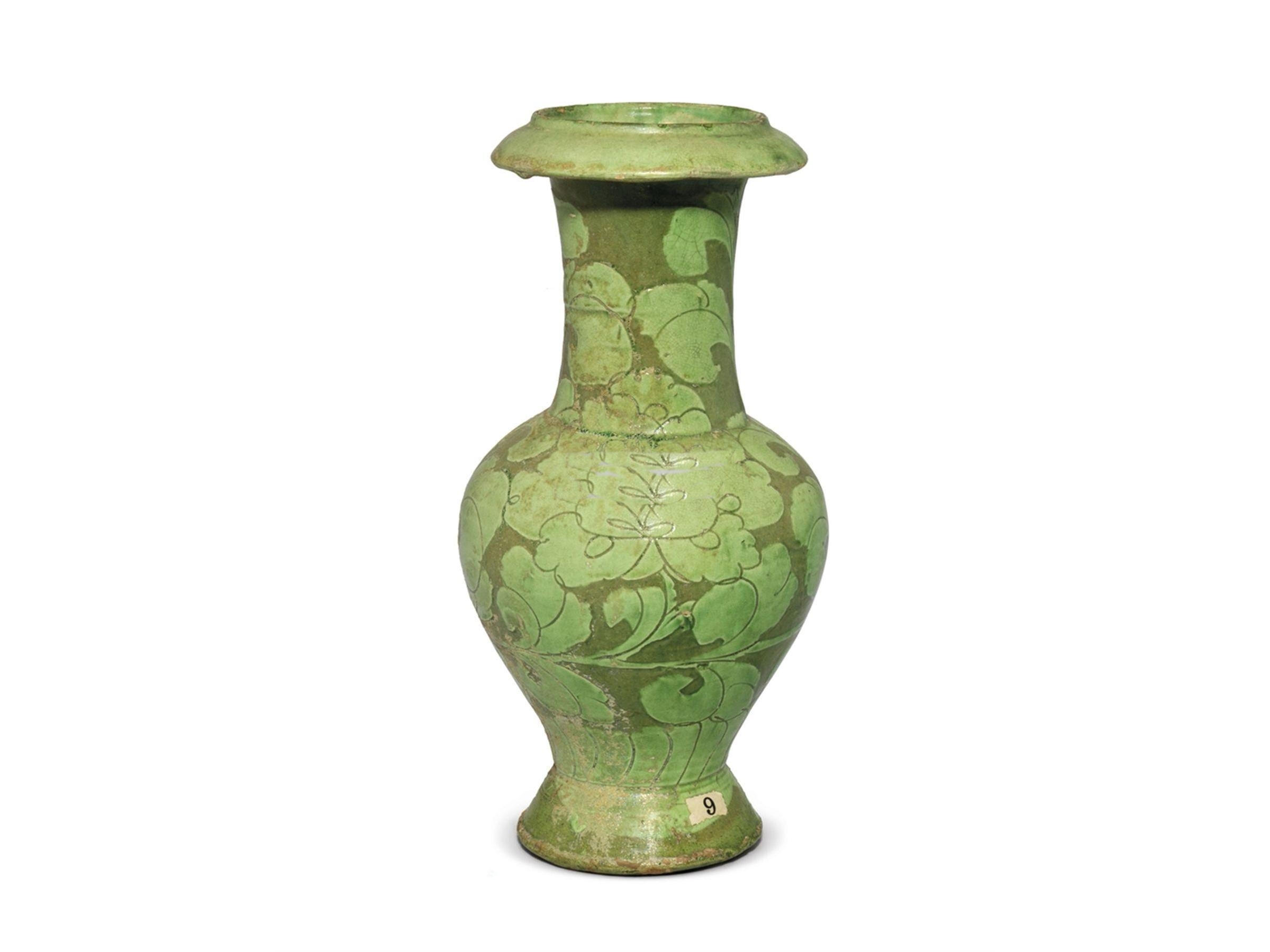
估 价 HKD 500,000-800,000
(折合人民币:424,620-679,392)
拍品已撤拍
参考:佳士得拍賣 2872
中國瓷器及工藝精品
紐約|2014年9月18日 – 19日
拍品758|PROPERTY FROM A PRIVATE CONNECTICUT COLLECTION
金-元 十二至十四世紀 磁州系白地褐彩花卉紋罐
JIN-YUAN DYNASTY 12TH-14TH CENTURY
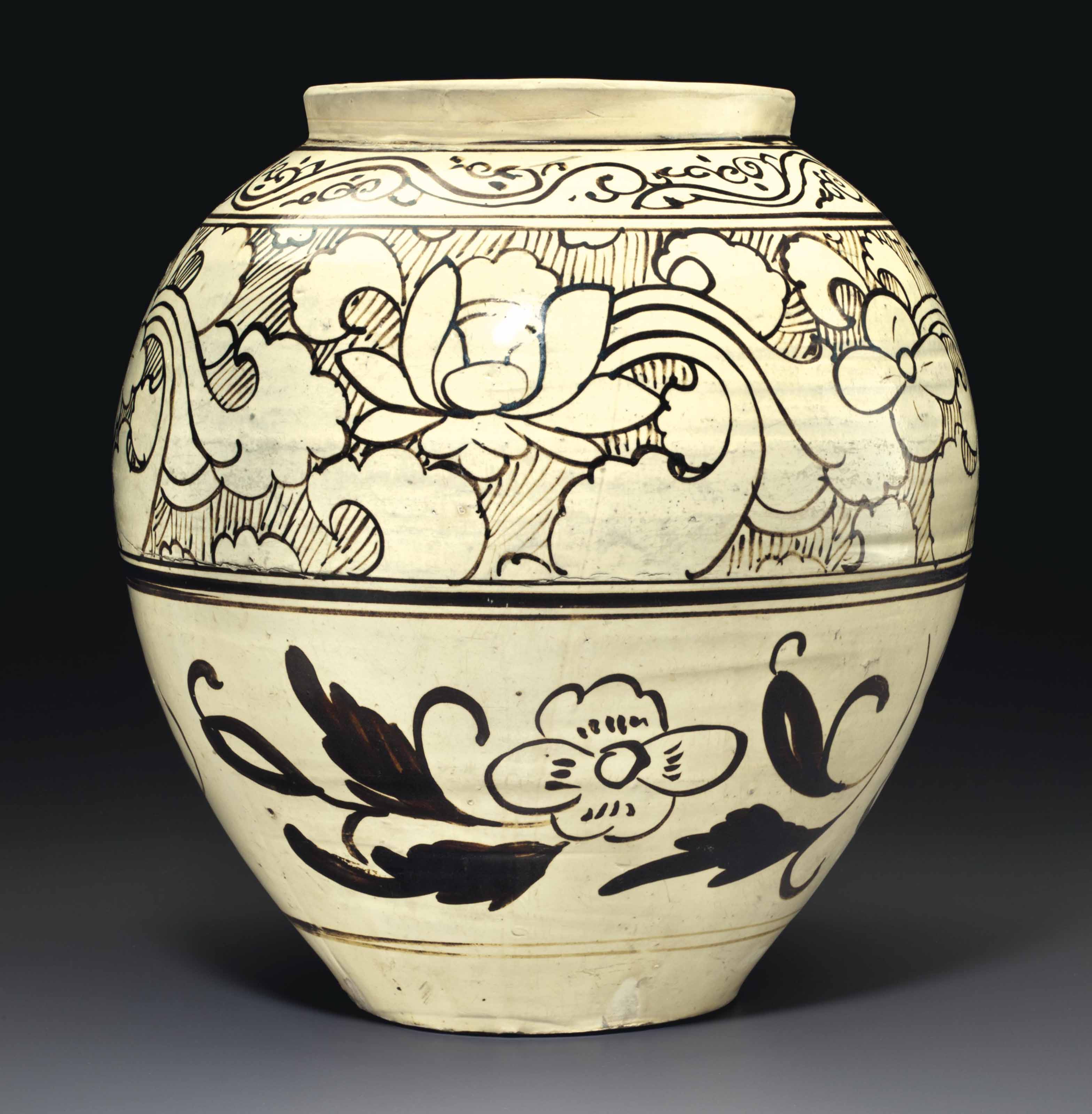
成交總額USD 16,250
估價USD 8,000 – USD 12,000
金-元 十二至十四世紀
磁州系白地褐彩花卉紋罐
來源
Frank Caro Gallery, New York.
参考:佳士得拍賣 1154
中國瓷器及工藝精品
倫敦|2013年11月5日
拍品398| 北宋 磁州窑水注
A RARE CIZHOU CARVED EWER
NORTHERN SONG DYNASTY, 10TH-11TH CENTURY
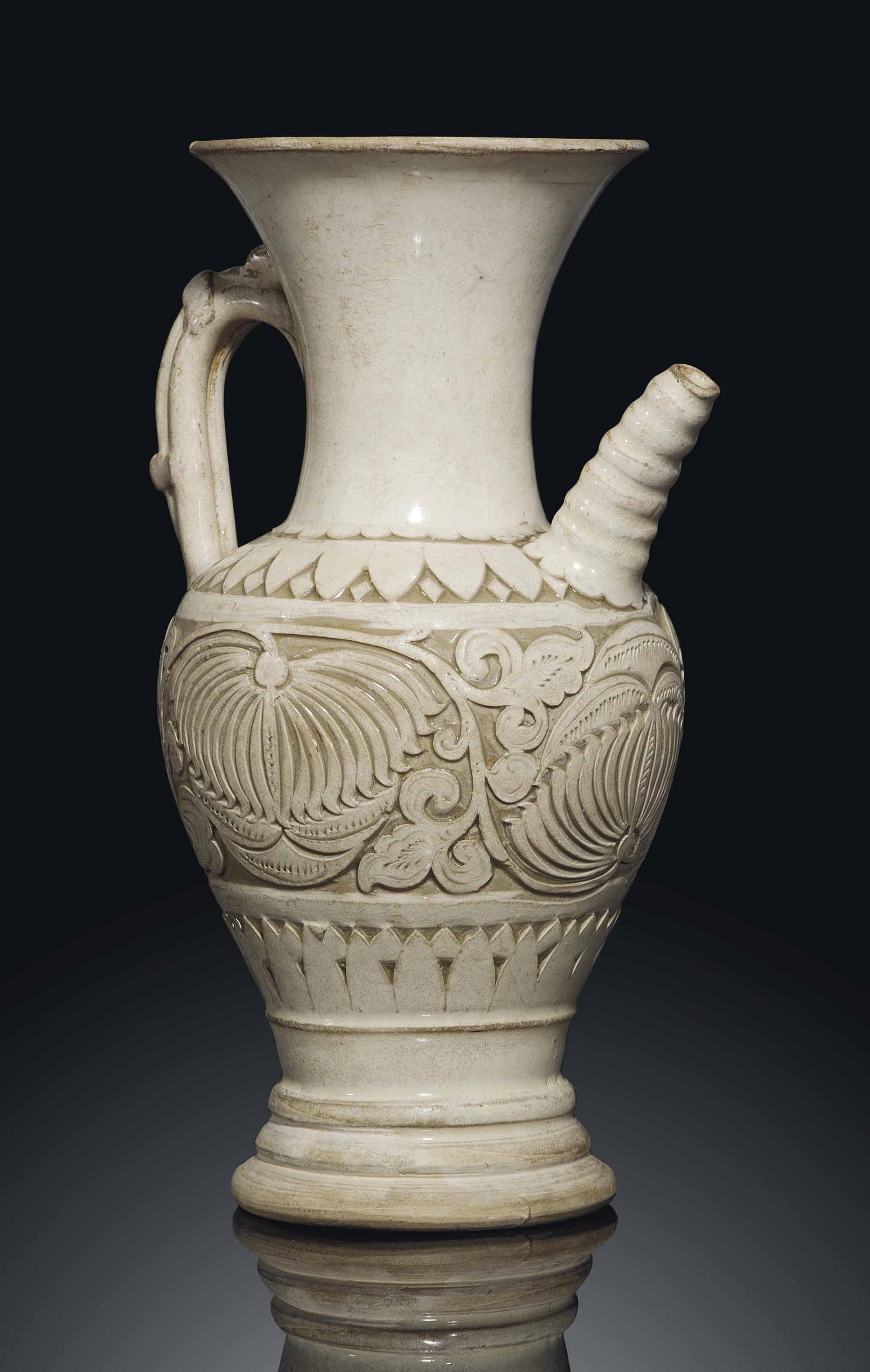
成交總額GBP 380,500
估價GBP 8,000 – GBP 12,000
A RARE CIZHOU CARVED EWER
NORTHERN SONG DYNASTY, 10TH-11TH CENTURY
The ewer is delicately potted with a bulbous body rising to a tall neck with a flaring mouth rim, supported on a stepped foot. The shoulder has a ridged spout to one side and a handle to the other side. The exterior of the body is carved through white slip with a continuous stylised floral scroll, set between two bands of overlapping petals.
9¼ in. (23.5 cm.) high
來源
With Spink & Son, Ltd., London, 4 November 1929.
Purchased by S.C. Bosch Reitz (1860 – 1938), bequeathed to his godchild Jonkheer G.C. Six van Wimmenum (1892 – 1975), and thence by descent to the present owner.
拍品專文
Examples of Cizhou ewers with similar decoration include one in the Tokyo National Museum, which is illustrated in Song Ceramics, Tokyo, 1999, p. 126, no. 87. A fragment of a vessel decorated in this style was found in 1962 at a kiln site at Quhezhen, Dengfengxian, Henan province, exhibited in Kiln Sites of Ancient China – Recent Finds of Pottery and Porcelain, Oriental Ceramic Society, London, 1980, p. 155, no. 389. Cizhou wares bearing this distinctive style of floral motif, deeply cut through the white slip on the surface of the vessel using the sgraffiato technique to reveal the buff-coloured clay beneath, tend to be attributed to this kiln site, which was active from the Tang to the Yuan dynasty, and reached its peak of production during the Song dynasty.
Interestingly a very similar floral scroll incised in simple lines through the white slip using a fine point can be seen on a Northern Song dynasty pillow excavated in 1989 at the Qingliangsi kiln site at Baofeng, Henan Province. It is illustrated in Ceramic Finds from Henan, University Museum and Art Gallery, University of Hong Kong, 1997, p. 83, pl. 54. Qingliangsi was also the site of imperial Ru ware production in the latter years of the Northern Song dynasty.
A large Cizhou vase decorated with a similar stylised floral scroll is in the collection of the Freer Gallery of Art, illustrated by G. Hasebe in Sekai toji zenshu – 12 – Song, Tokyo, 1977, pp. 110-11, no. 109. Another comparable Cizhou vase shape is in the collection of the Museum of Fine Arts, Boston, illustrated in Oriental Ceramics, The World’s Great Collections, vol. 10, Tokyo, New York, San Francisco, 1980, colour pl. 11. Other Cizhou vases with similar designs to the current lot include one in the Indianapolis Museum of Art, illustrated by Y. Mino and J. Robinson in Beauty and Tranquility: The Eli Lilly Collection of Chinese Art, Indianapolis Museum of Art, 1983, pp. 186-7, no. 67, another sold in Hong Kong in May 1989 from the British Rail Pension Fund, and another in the Minneapolis Museum of Art, illustrated by Y. Mino in Freedom of Clay and Brush through Seven Centuries in Northern China: Tz’u-chou Type Wares, 960-1600 A.D., Indiana University Press, 1980, p. 42, fig. 16.
The style of floral scroll on the current Cizhou vase, which is characterized by flower heads with narrow sharply cut petals, also appears on early Northern Song ceramics from kilns which were patronized by the court. It can be seen, for example, on the shoulder of a Ding ware vase excavated in 1969 from the so-called ‘underground palace’ of a pagoda at the Jingzhongyuan Temple at Dingzhou, Hebei province, illustrated in Treasures from the Underground Palaces – Excavated Treasures from Northern Song Pagodas, Dingzhou, Hebei Province, China, Idemitsu Museum of Arts, Japan, 1997, no. 88. Along with other treasures, this Ding vase was sealed into the base of the pagoda when it was built in AD 995. A similar floral scroll also appears on a Yaozhou celadon ewer in the collection of the Asian Art Museum in San Francisco, illustrated by G. Hasebe in op.cit., pl. 187. It is a style of floral decoration that appears to have found particular favour in the early part of the Northern Song dynasty.
Also compare the present lot to a very similarly decorated Cizhou vase sold in our New York rooms, 19 March 2009, lot 508.
編製圖錄及詳情
THE PROPERTY OF A EUROPEAN GENTLEMAN
Sigisbert Chretien Bosch Reitz was born on 30 February 1860 in Amsterdam. He was originally trained for a career in commerce, but at the age of 23 he decided he wanted to be a painter. His wanderlust and preference for painting in the open air brought him to various European artists’ villages such as Pont-Aven, also visited by Gauguin in 1886, and St. Ives, important to the English art scene. Around 1900 he visited the distant country of Japan, an almost mandatory journey for European artists in the fin-de-siècle. For a year he studied porcelain, drawings and woodcuts. After his return to Laren in 1901, Bosch Reitz developed his knowledge of Asian Art and subsequently was appointed the first curator of the Department of Far Eastern Art at the Metropolitan Museum of Art in New York in 1915, where he remained until 1927. As a curator, he made important purchases for the museum as well as for the Freer Gallery of Art in Washington and the Museum of Fine Arts in Boston.
In 1928 Bosch Reitz returned to the Netherlands where he lived until his death in 1938. After his death all the paintings and his collection of historical costumes, Japanese prints and porcelain were left to his family.
参考:佳士得
拍卖 16271 磁州窑集珍:古韵天成-临宇山人珍藏(四)
纽约|2018年9月13日
拍品831 A RARE PAINTED CIZHOU DEEP BOWL JIN DYNASTY (1115-1234)
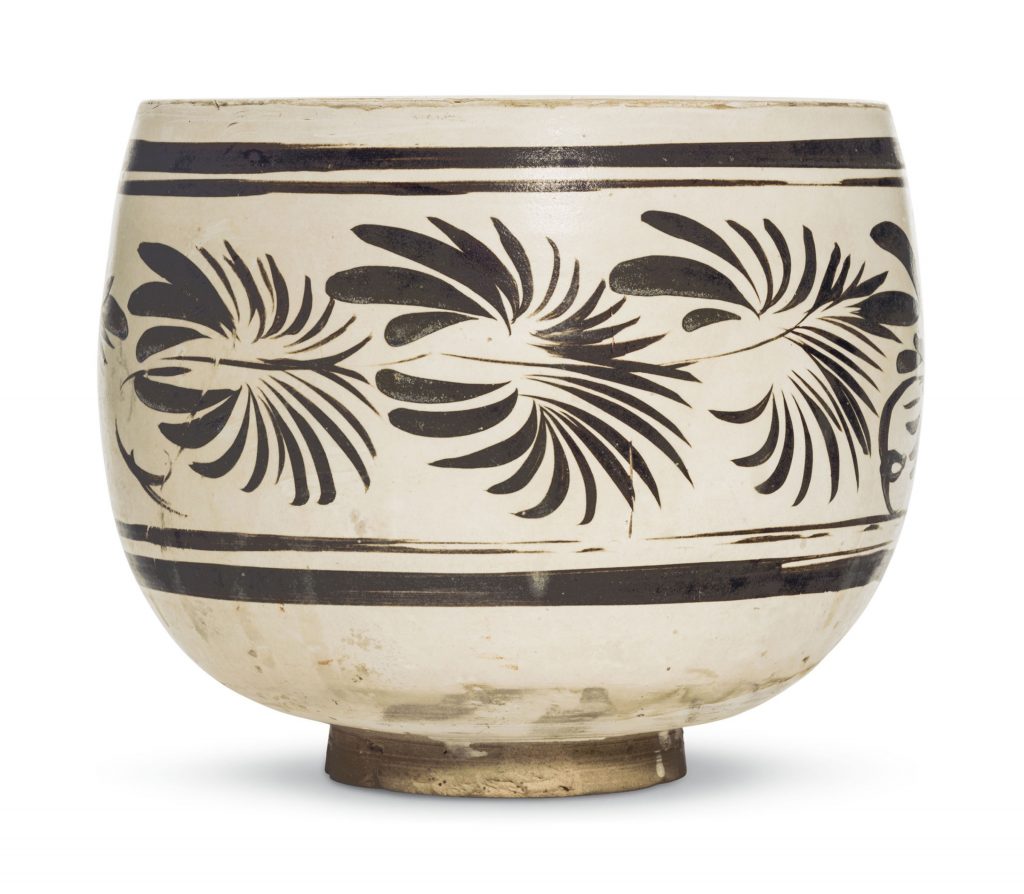
纽约|2018年9月13日
拍品831 A RARE PAINTED CIZHOU DEEP BOWL JIN DYNASTY
成交总额USD 40,000
估价USD 15,000 – USD 18,000
A RARE PAINTED CIZHOU DEEP BOWL
JIN DYNASTY (1115-1234)
The finely potted body is raised on a high foot ring and covered with a white slip painted in dark brown with a band of abstract leaves, all under a clear glaze that stops on the lower body to reveal the pale grey ware.
7 ¼ in. (18.8 cm.) high, Japanese wood box, lacquer cover
来源
The Idemitsu Collection, prior to 1979.
Sen Shu Tey, Tokyo.
文獻及展覽
文献
Idemitsu Art Museum, The Ceramics of Song Dynasty, Tokyo, 1979, no. 107.
Fujio Koyama (ed.), Chinese Ceramics in the Idemitsu Collection, Tokyo, 1987, no. 515.
展览
Idemitsu Art Museum, The Ceramics of Song Dynasty, Tokyo, 1979.
参考:佳士得
拍卖 16271 磁州窑集珍:古韵天成-临宇山人珍藏(四)
纽约|2018年9月13日『磁州窑集珍:古韵天成-临宇山人珍藏』
拍品826 A RARE CIZHOU SGRAFFIATO VASE, YUHUCHUNPING
NORTHERN SONG-JIN DYNASTY (960-1234)
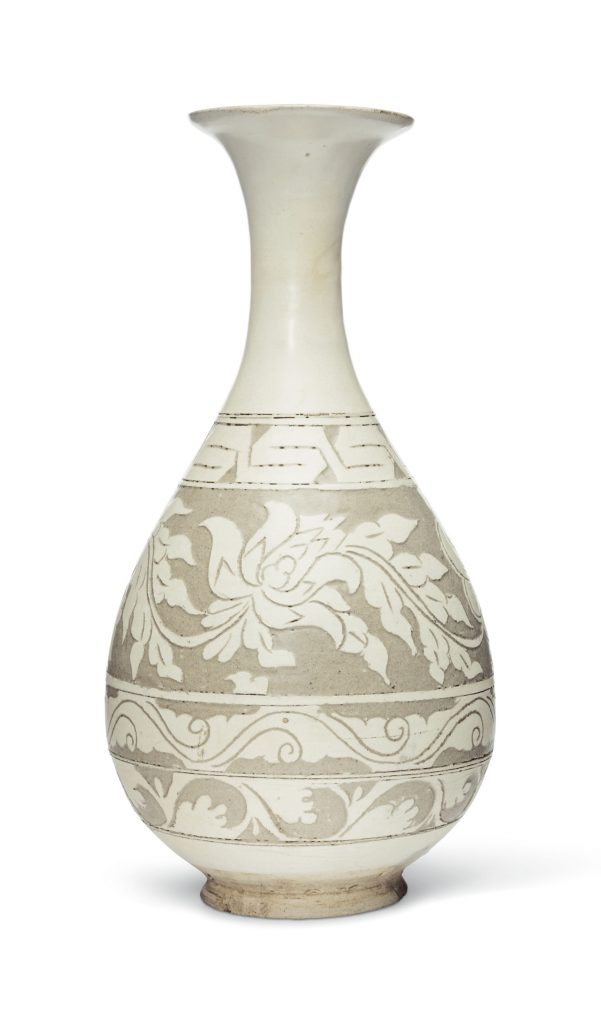
拍品826 A RARE CIZHOU SGRAFFIATO VASE, YUHUCHUNPING
NORTHERN SONG-JIN DYNASTY
成交总额USD 87,500
估价USD 20,000 – USD 30,000
A RARE CIZHOU SGRAFFIATO VASE, YUHUCHUNPING
NORTHERN SONG-JIN DYNASTY (960-1234)
The pear-shaped body is carved through the white slip to the pale beigish-grey ground with a wide band of floral scroll beneath a band of stylized key-fret at the shoulder and above decorative leaf bands above the foot, all under a clear glaze that falls in an irregular line towards the foot ring.
10 3/8 in. (26.3 cm.) high, Japanese wood box
拍品专文
Cizhou sgraffiato vases of this yuhuchunping shape with the decoration carved through a white slip rather than a dark brown glaze appear to be quite rare. One of similar type, also with the decoration arranged in bands around the body and neck, is illustrated in Song Ceramics from the Kwan Collection, Hong Kong Museum of Art, 1994, no. 197.
参考:佳士得 拍卖 12563重要中国瓷器及工艺精品 Hong Kong, HKCEC Grand Hall|2016年11月30日 拍品3387 A RARE GREEN-GLAZED CIZHOU SGRAFFIATO ‘PEONY’ VASE NORTHERN SONG-JIN DYNASTY, 12TH CENTURY
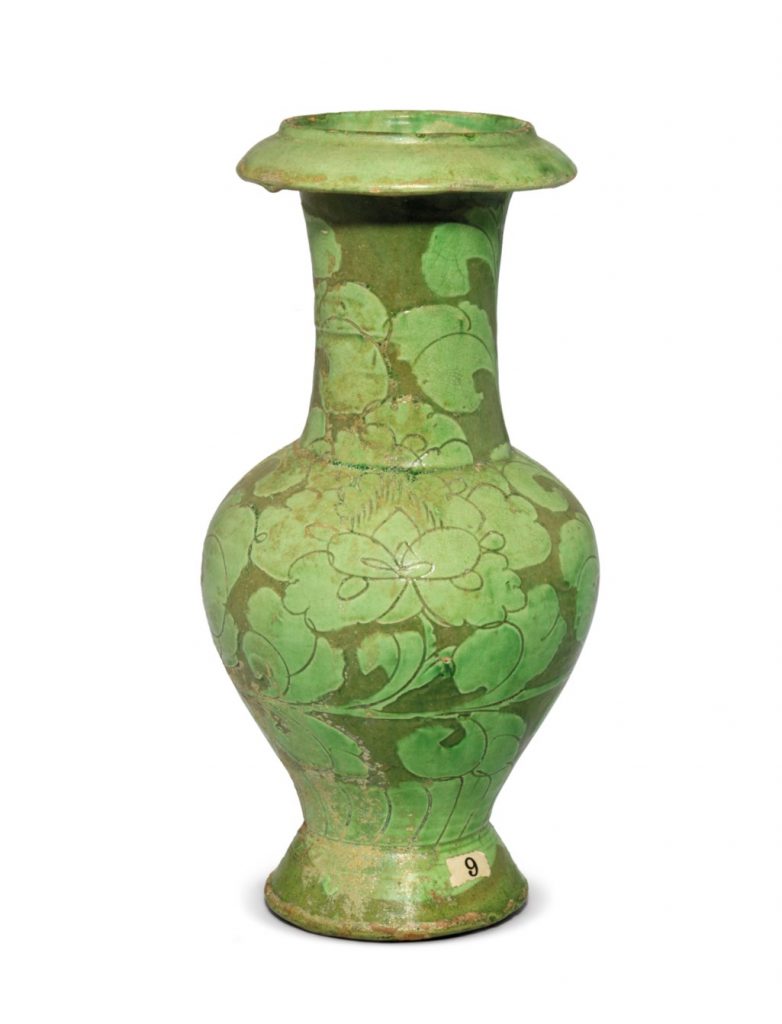
拍品 3123 A RARE GREEN-GLAZED CIZHOU SGRAFFIATO ‘PEONY’ VASE
成交总额 HKD 2,940,000
估价 HKD 500,000 – HKD 800,000
A RARE GREEN-GLAZED CIZHOU SGRAFFIATO ‘PEONY’ VASE
NORTHERN SONG-JIN DYNASTY, 12TH CENTURY
The well-balanced baluster body is supported on a high splayed foot and with a tall tapering neck ending on a wide rolled-out everted rim, delicately carved and incised with two large peony blooms borne on leafy stems, all above a band of overlapping petals at the base.
11 in. (31 cm.) high
来源
Acquired by a European collector from Kusaka Shogado,Tokyo, in the 1930s and thence by descent
Sold at Christie’s London, 12 May 2009, lot 153
拍品专文
Green-glazed Cizhou vases of this shape and decoration are extremely rare. Most known examples have the same peony decoration rendered in black slip, while the current vase is carved through white slip and covered with a translucent green glaze. The only known other example also decorated with white peony motifs under a green glaze is illustrated in Mayuyama Seventy Years, vol. 1, Tokyo, 1976, pl. 556, registered as an Important Art Object (fig. 1).
Other green-glazed Cizhou vases decorated with peony in black slip include one in the Linyushanren Collection, exhibited in The Classic Age of Chinese Ceramics: An Exhibition of Song Treasures from the Linyushanren Collection, Christie’s Hong Kong, 2012, pl. 52; one from the Museum Yamoto Bunkakan, illustrated in Mayuyama Seventy Years, op. cit., pl. 557; one illustrated in Sekai toji zenshu, vol. 12, Tokyo, 1977, p. 242, fig. 237; one from the Idemitsu Museum of Art, Tokyo, illustrated in Chinese Ceramics in the Idemitsu Museum Collection, Tokyo, 1986, pl. 117; and one in the Baur Collection, Geneva, illustrated in J. Ayers, The Baur Collection, Chinese Ceramics I, Switzerland, 1968, pl. A78.
CIRAM Scientific Analysis Certificate no. 0714-OA-207R is consistent with the dating of this lot.
参考: 纽约大都会博物馆 中國 元 磁州窯牡丹纹甁 Bottle decorated with peonies 13th–early 14th century China
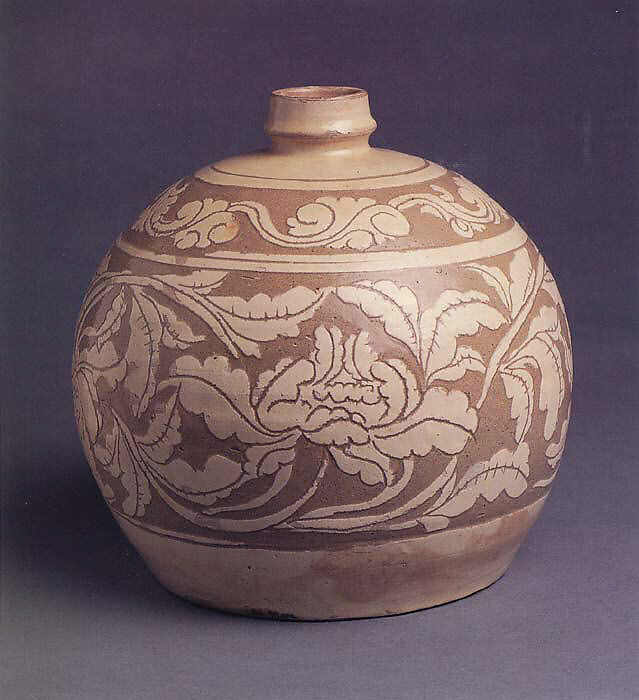
Object Details
Period:Jin (1115–1234) or Yuan (1271–1368) dynasty
Date:13th–early 14th century
Culture:China
Medium:Stoneware with sgraffito design (Cizhou ware)
Dimensions:H. 7 3/4 in. (19.8 cm)
Classification:Ceramics
Credit Line:Gift of Stanley Herzman, in memory of Adele Herzman, 1991
Accession Number:1991.253.21
Provenance
Stanley Herzman , New York (until 1991; donated to MMA)
Exhibition History
New York. The Metropolitan Museum of Art. “A Selection of Chinese Ceramics from the Adele and Stanley Herzman Collection,” June 1, 1990–August 26, 1990.
Timeline of Art History
Timelines
Central and North Asia, 1000-1400 A.D.
China, 1000-1400 A.D.
IMPORTANT CHINESE ART
11 SEPTEMBER 2019 | 10:30 AM EDT NEW YORK
704 IMPORTANT CHINESE ART, SOLD BY THE ART INSTITUTE OF CHICAGO
A PAINTED ‘CIZHOU’ JAR, SONG / JIN DYNASTY

A PAINTED ‘CIZHOU’ JAR, SONG / JIN DYNASTY
30,000 — 50,000 USD
A PAINTED ‘CIZHOU’ JAR
SONG / JIN DYNASTY
well-potted, of slightly compressed globular form rising from a short spreading foot, the body deftly painted on the exterior with a wide, continuous band of interlaced ‘cash’ symbols in dark brown slip against an ivory-white ground, all beneath a lustrous transparent glaze stopping short of the base revealing the buff-colored stoneware body, the interior a plain creamy-white
Height 5 5/8 in., 14.3 cm
PROVENANCE
Collection of Mrs. Potter Palmer (1849-1918) and thence by descent.
Gifted to the Art Institute of Chicago, Chicago by Bertha Palmer Thorne (1911-1974) in 1973 (acc. no. 1973. 825).
LITERATURE
Freedom of Clay and Brush through Seven Centuries in Northern China: Tz’u-chou Type Wares, 960-1600 A.D., Indianapolis Museum of Art, Indianapolis, 1980, p. 152, fig. 173.
CATALOGUE NOTE
Usually painted with floral motifs, examples decorated with similar ‘cash’ patterns are exceptionally rare. An incised jar of the same form and decoration but with the design in white on a dark brown ground, from the Linyushanren Collection, is illustrated in several publications including Special Exhibition, Charm of Black & White Ware; Transition of Cizhou Type Wares, The Osaka Municipal Art Museum, Osaka, 2002, cat. no. 47, and was sold at Christie’s New York, 22nd March 2018, lot 508. For a vessel of the same form with dark brown painted floral decoration, see an example excavated at the Guantai kiln, Hebei, illustrated in Guantai Cizhou yaozhi [The Cizhou Kiln Site at Guantai], Beijing, 1997, pl. XIV, no. 2.
参考:
纽约大都会博物馆
金 花草纹罐
Jar with Abstract Floral Design
12th–13th century
China
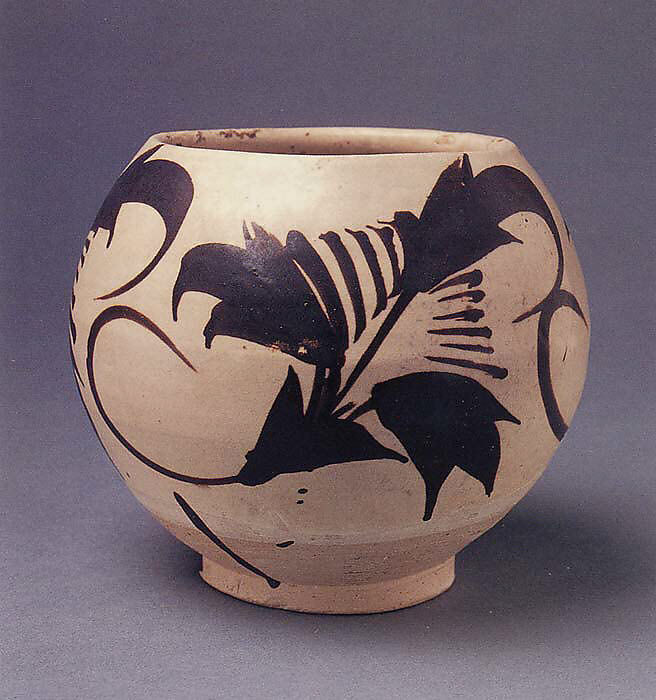
Object Details
Period:Jin dynasty (1115–1234)
Date:12th–13th century
Culture:China
Medium:Stoneware painted in dark brown on white slip (Cizhou ware, probably Guantai kilns)
Dimensions:H. 4 7/8 in. (12.4 cm); Diam. 5 5/8 in. (14.3 cm); Diam. of rim 3 7/8 in. (9.8 cm); Diam. of foot 2 3/4 in. (7 cm)
Classification:Ceramics
Credit Line:Gift of Stanley Herzman, in memory of Adele Herzman, 1991
Accession Number:1991.253.20
Provenance
Stanley Herzman , New York (until 1991; donated to MMA)
Exhibition History
New York. The Metropolitan Museum of Art. “A Selection of Chinese Ceramics from the Adele and Stanley Herzman Collection,” June 1, 1990–August 26, 1990.
Timeline of Art History
Timelines
Central and North Asia, 1000-1400 A.D.
China, 1000-1400 A.D.

![[临渊阁]天地一家春](https://www.antiquekeeper.ca/wp-content/uploads/2023/03/cropped-Asian-Art-Wallpaper-Painting3-6-3.jpg)
